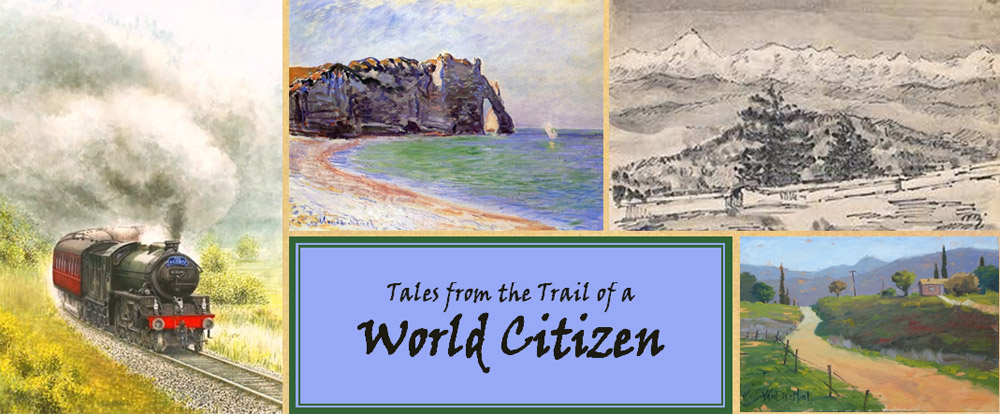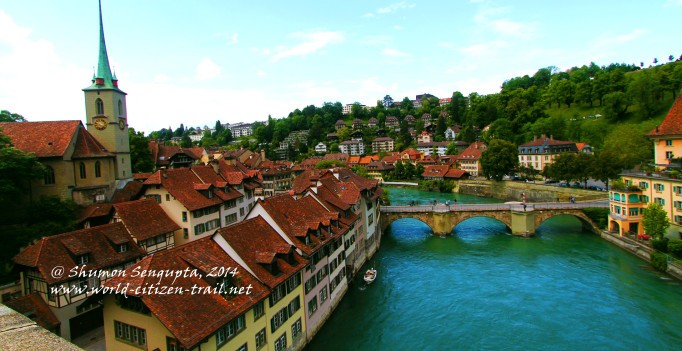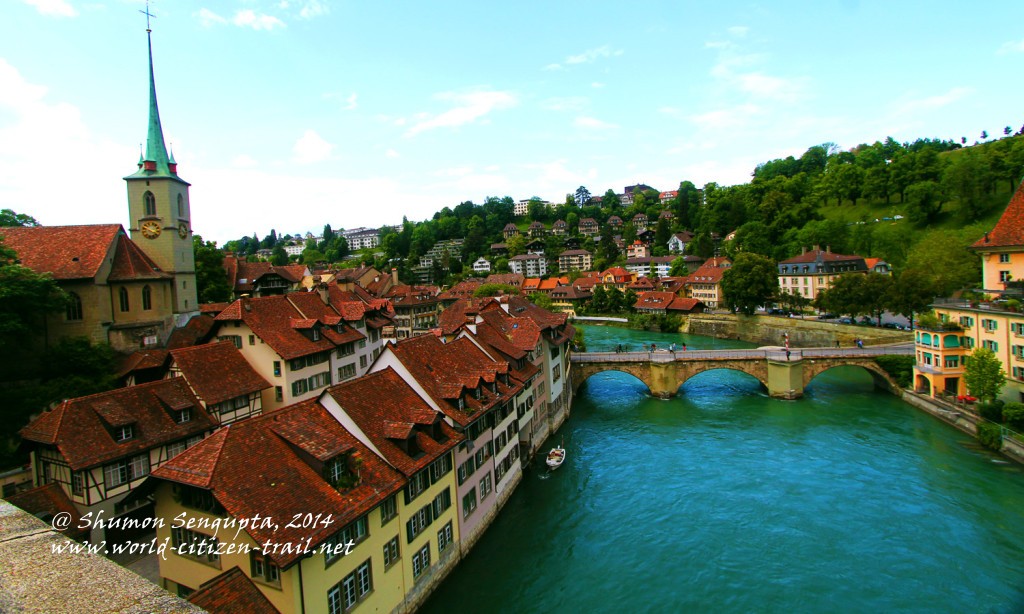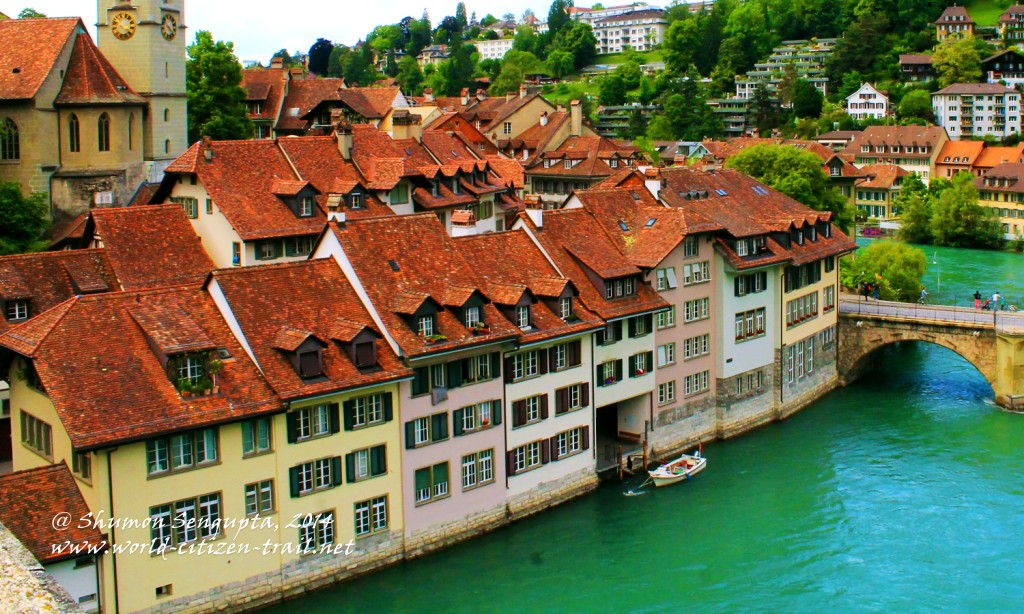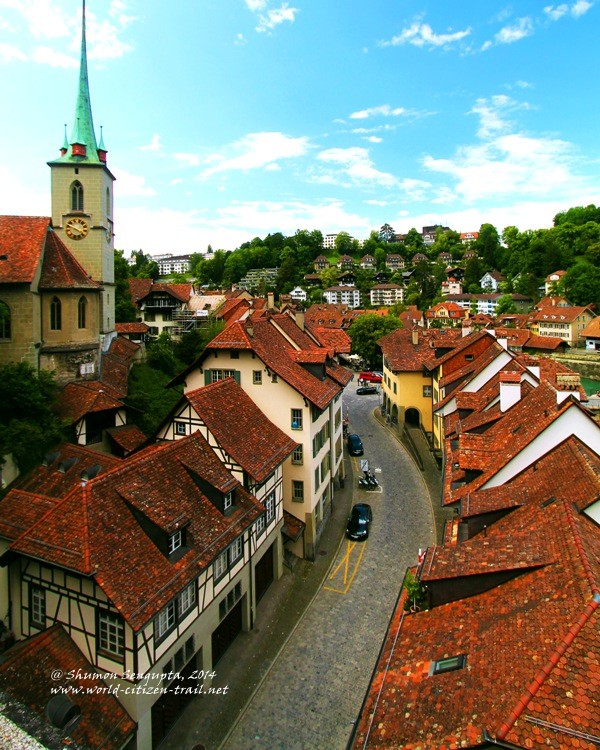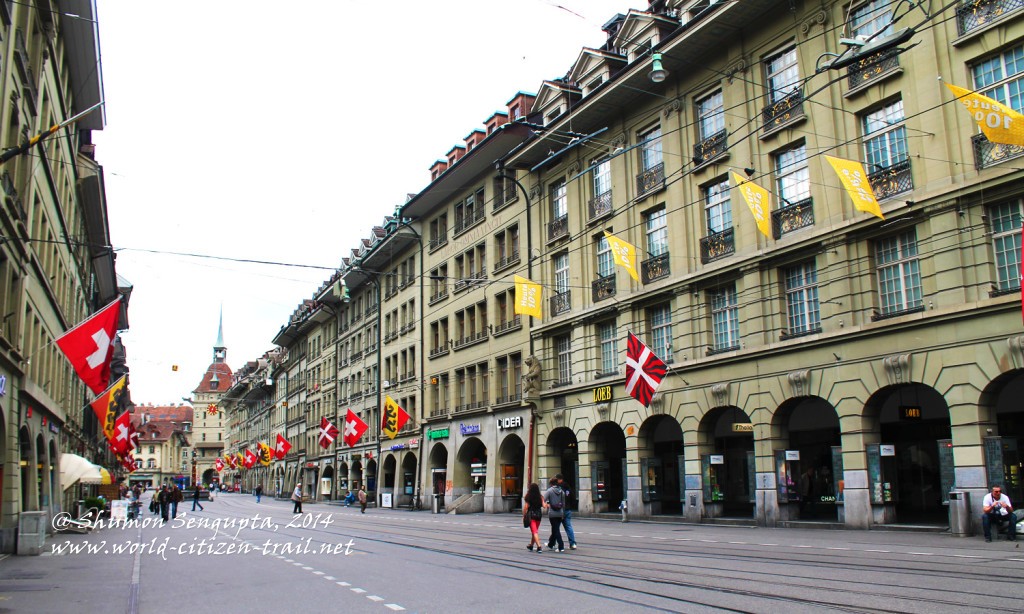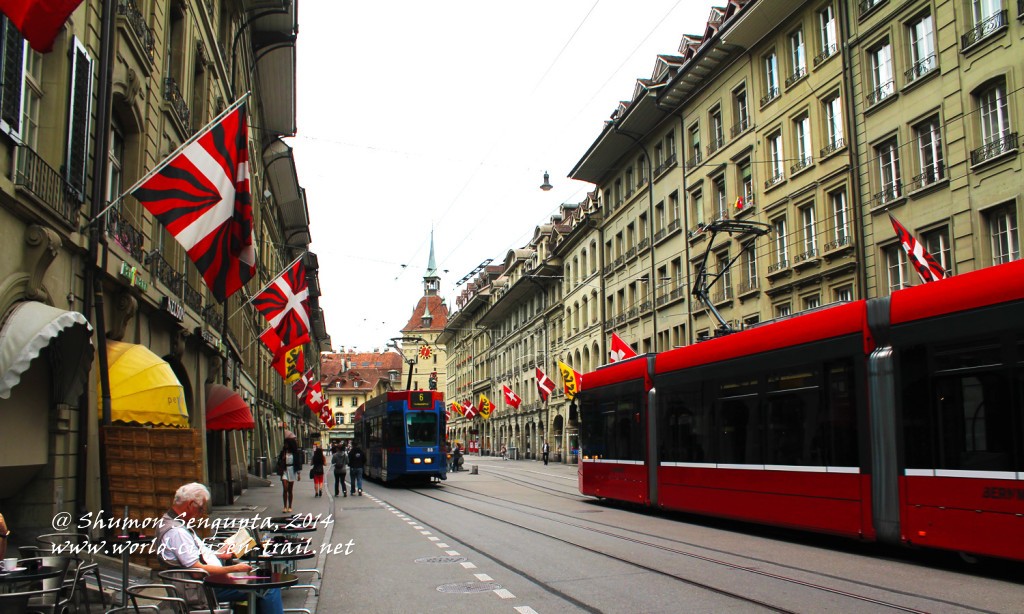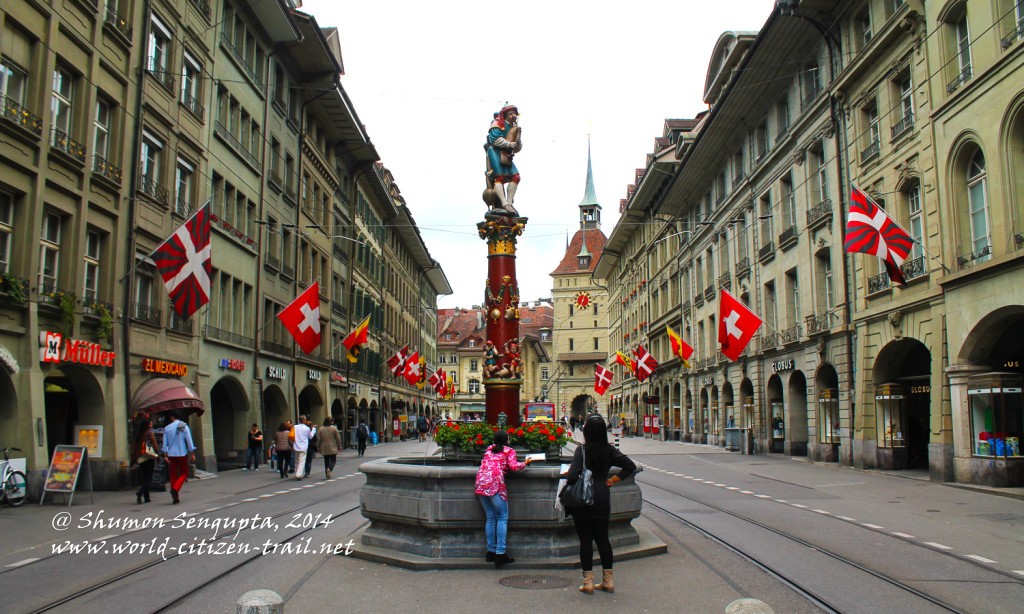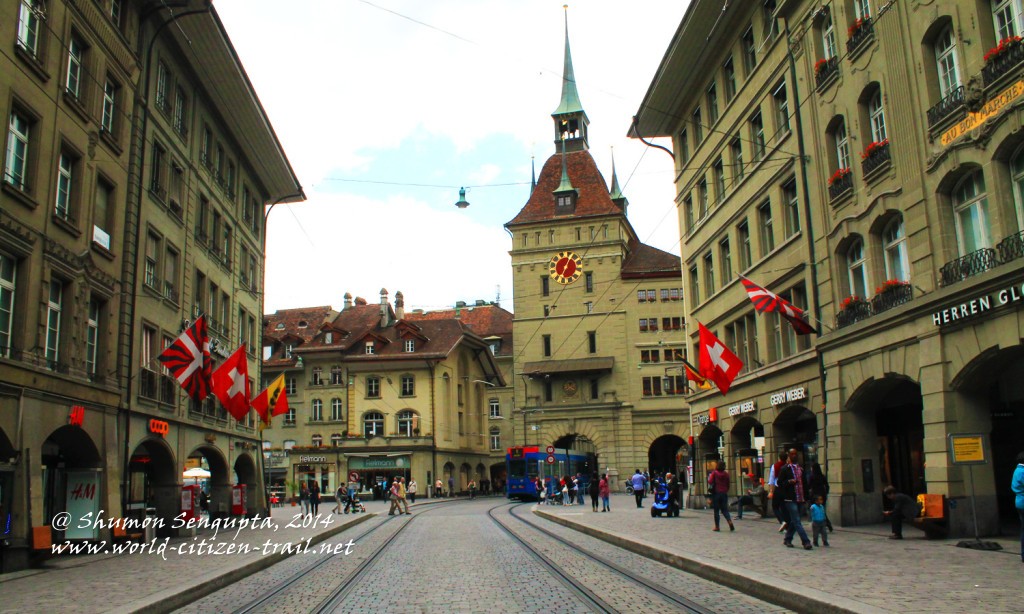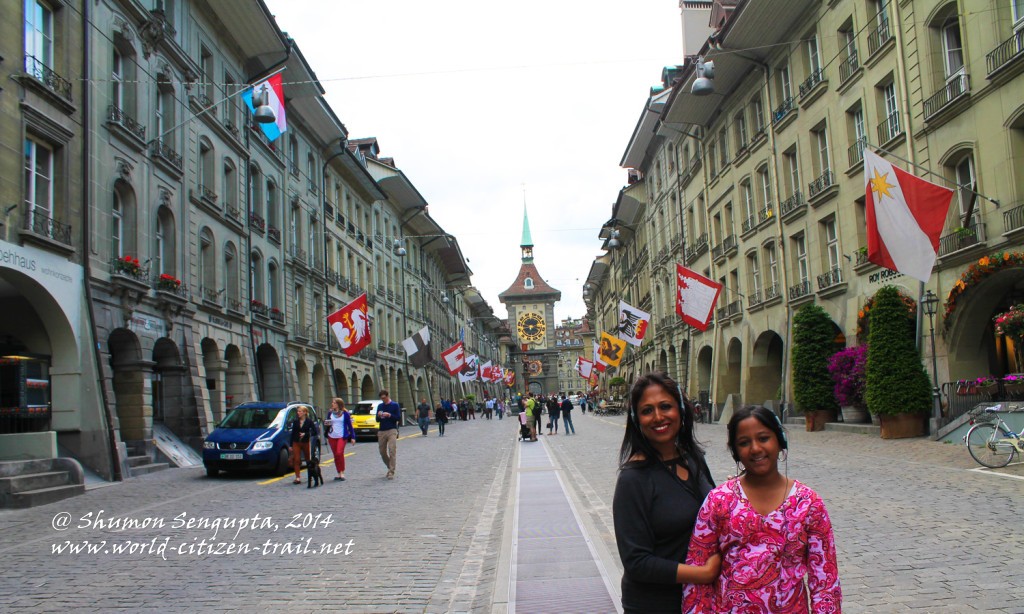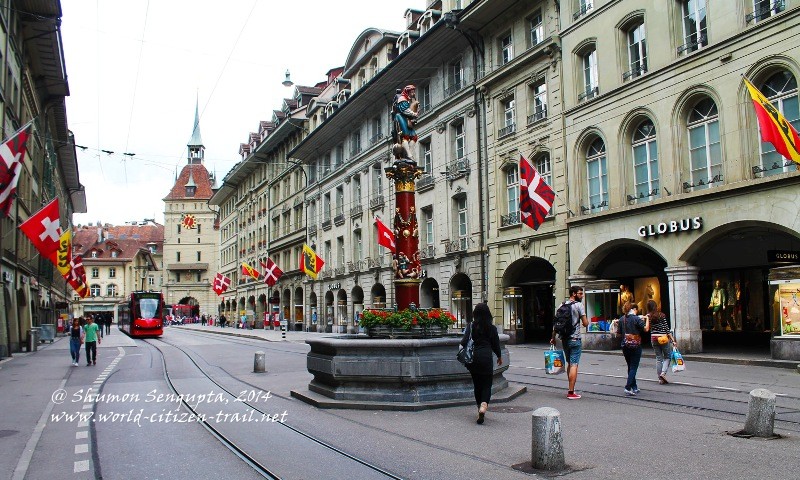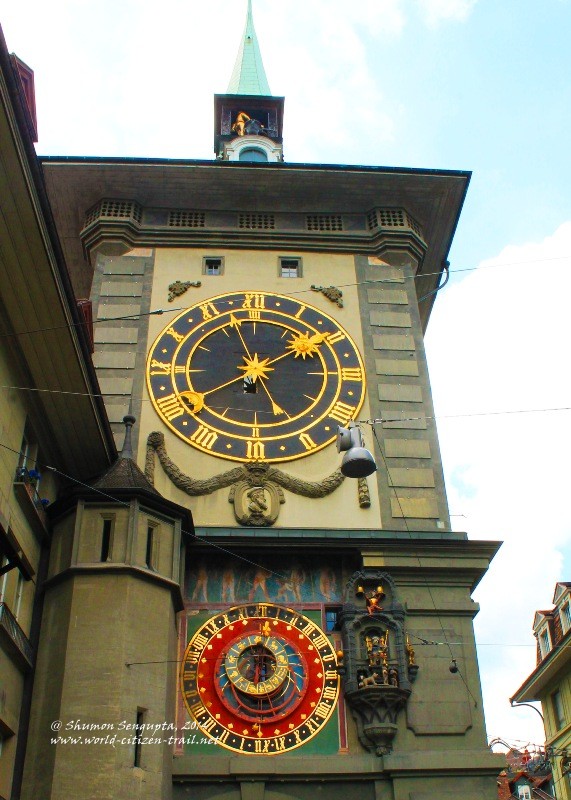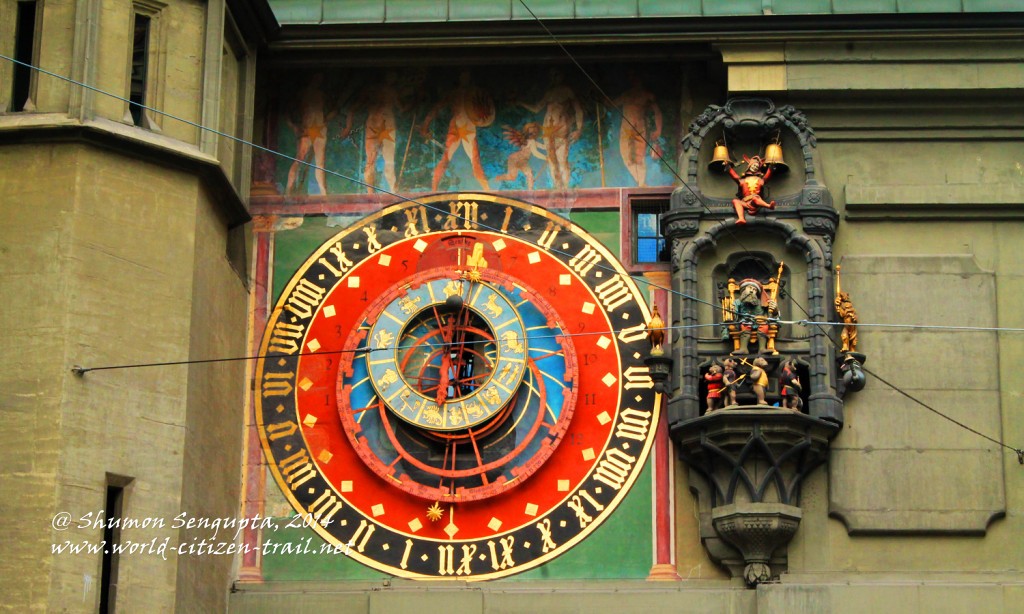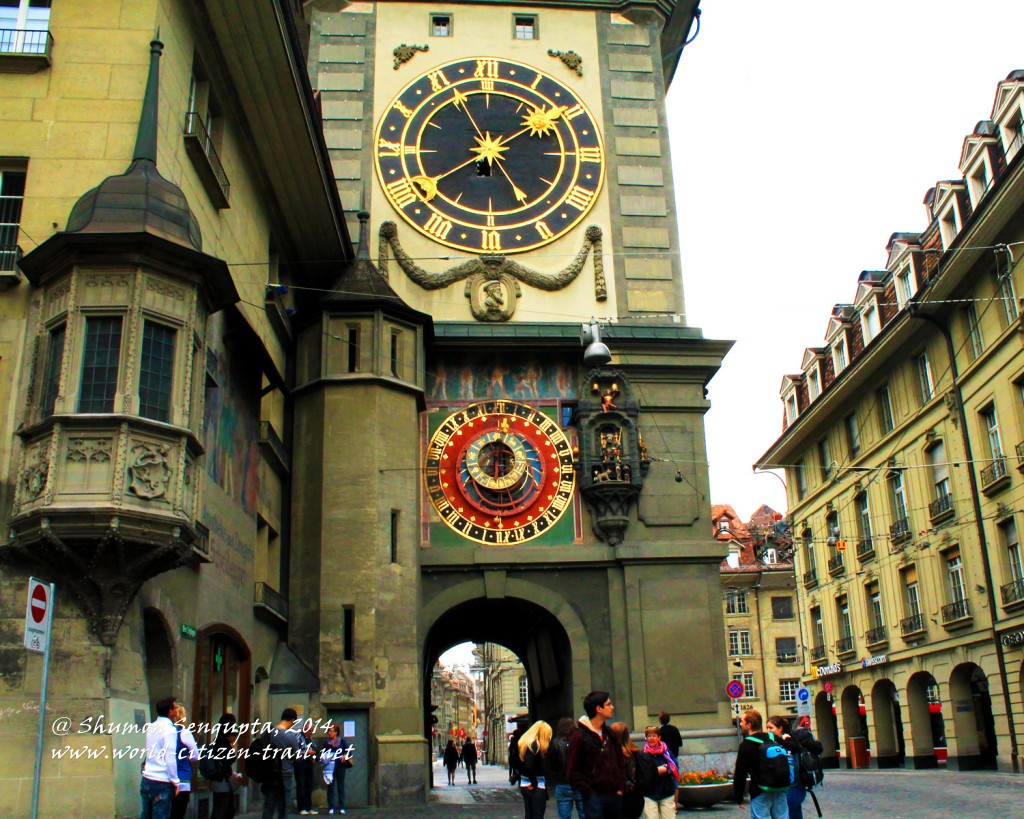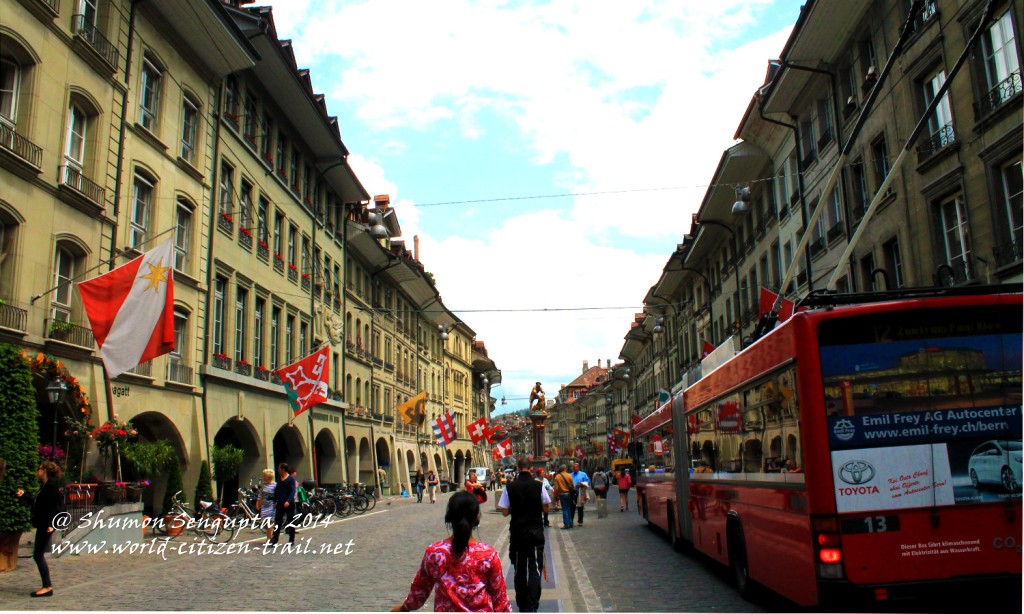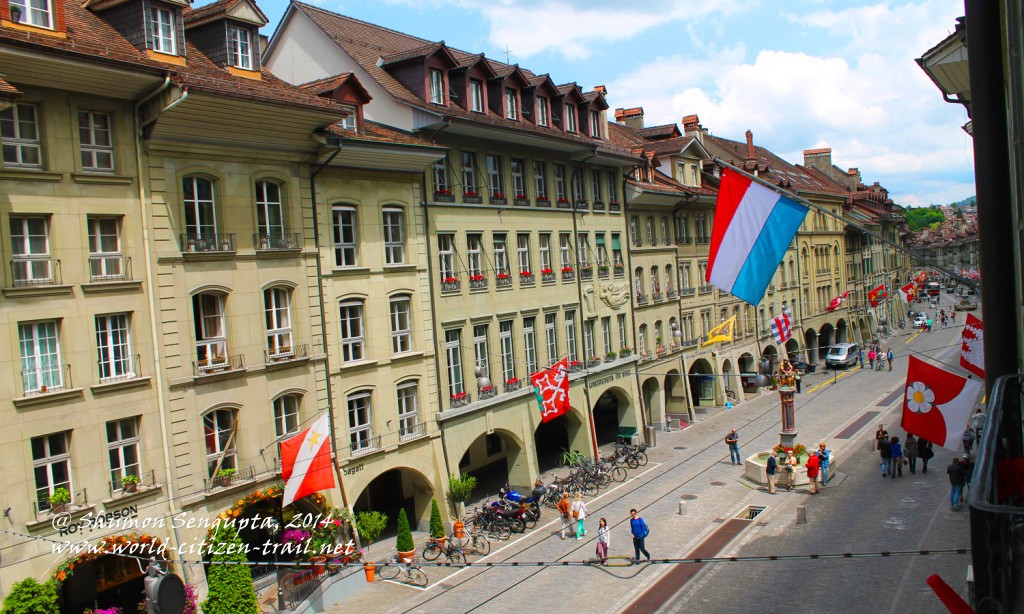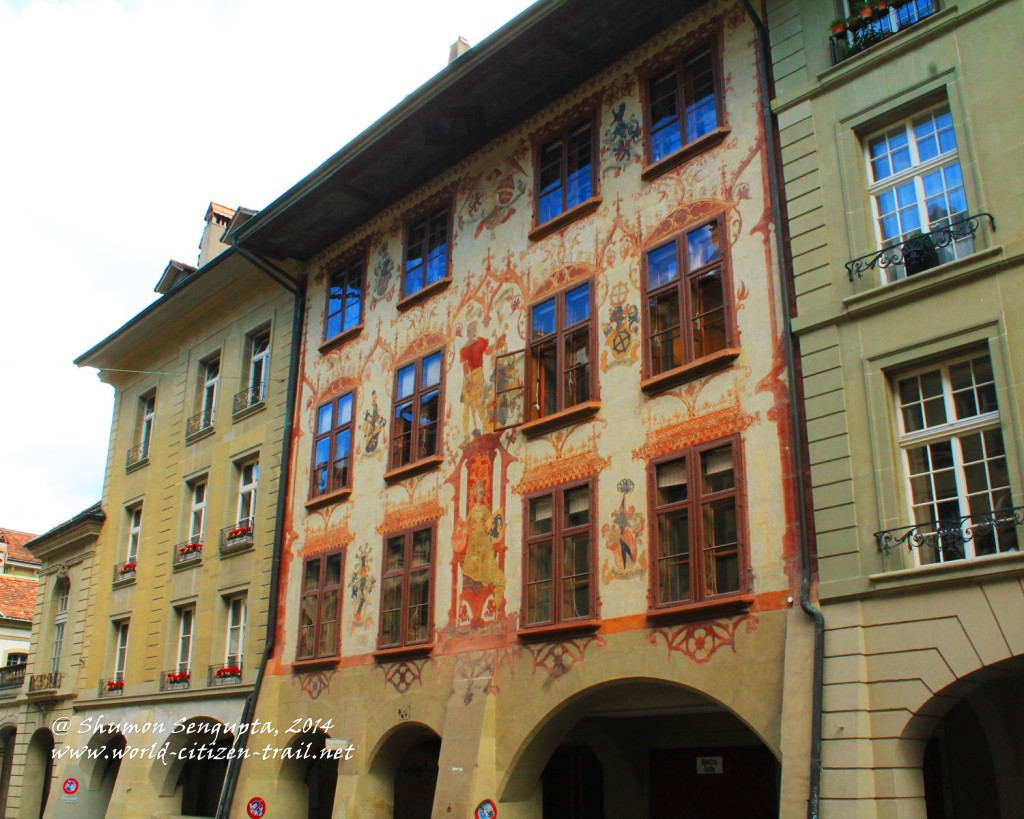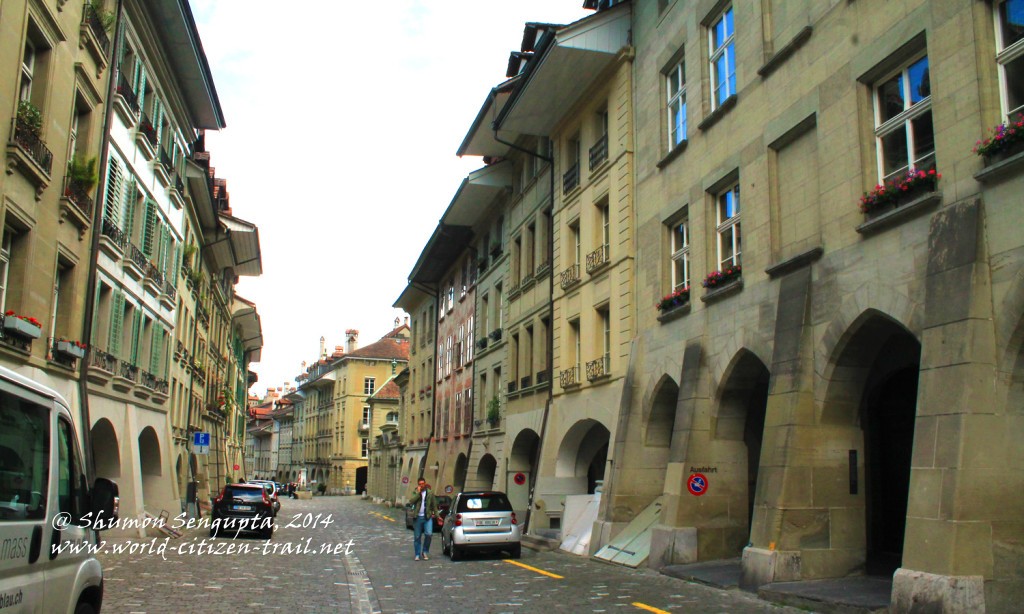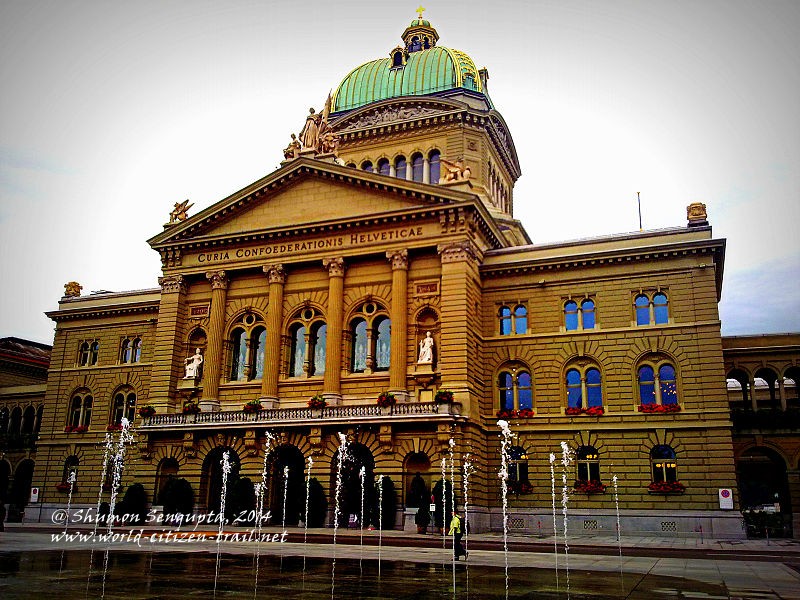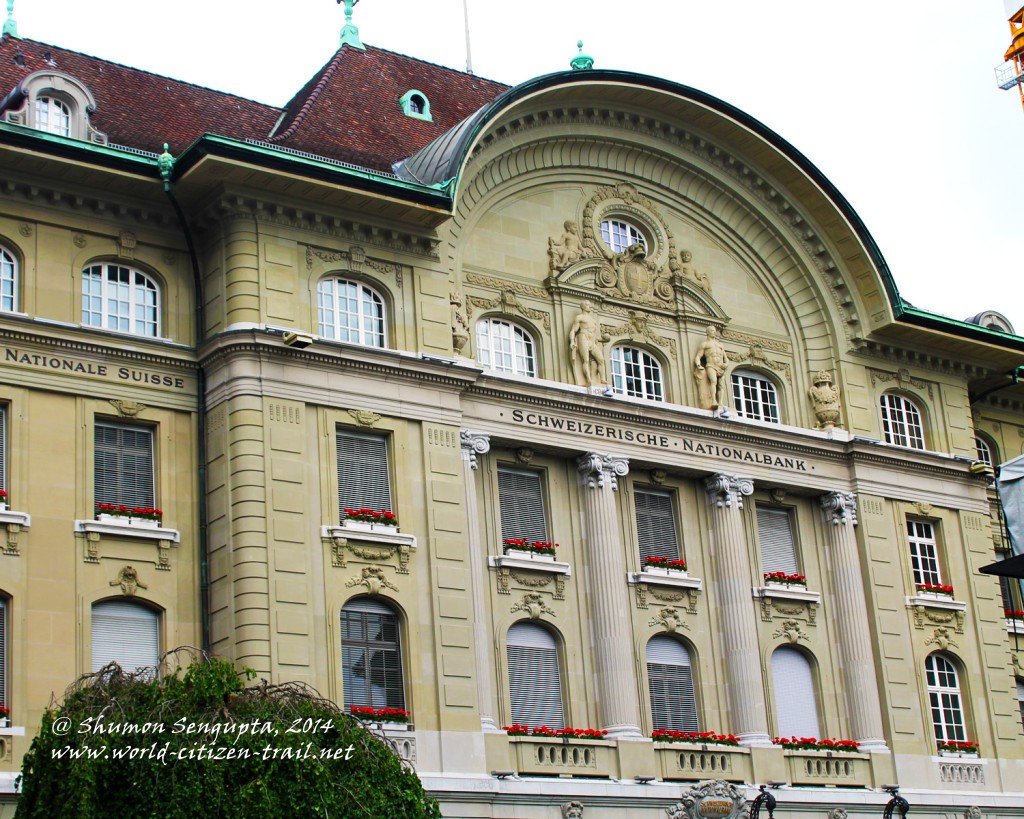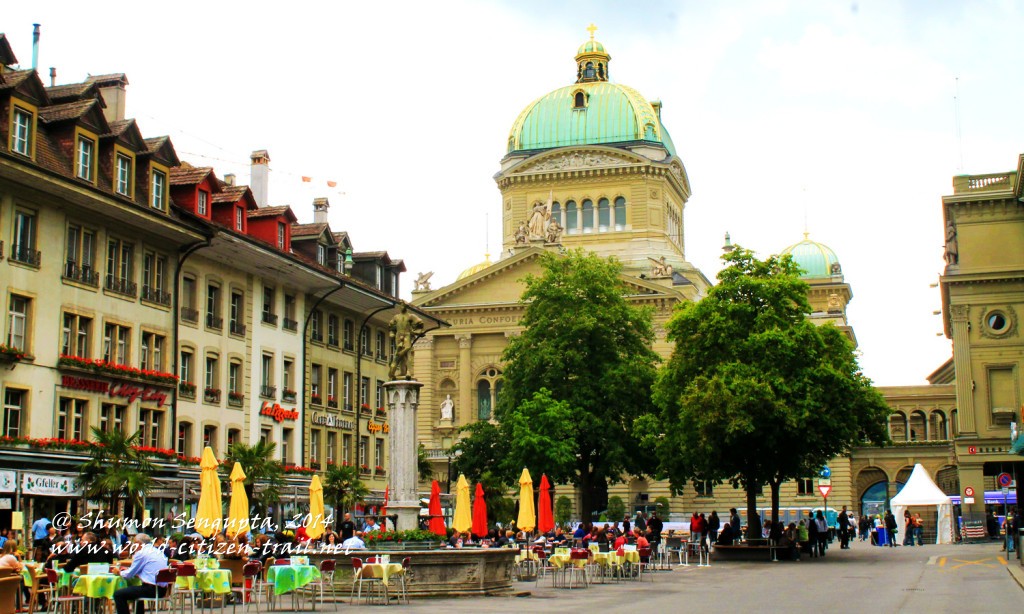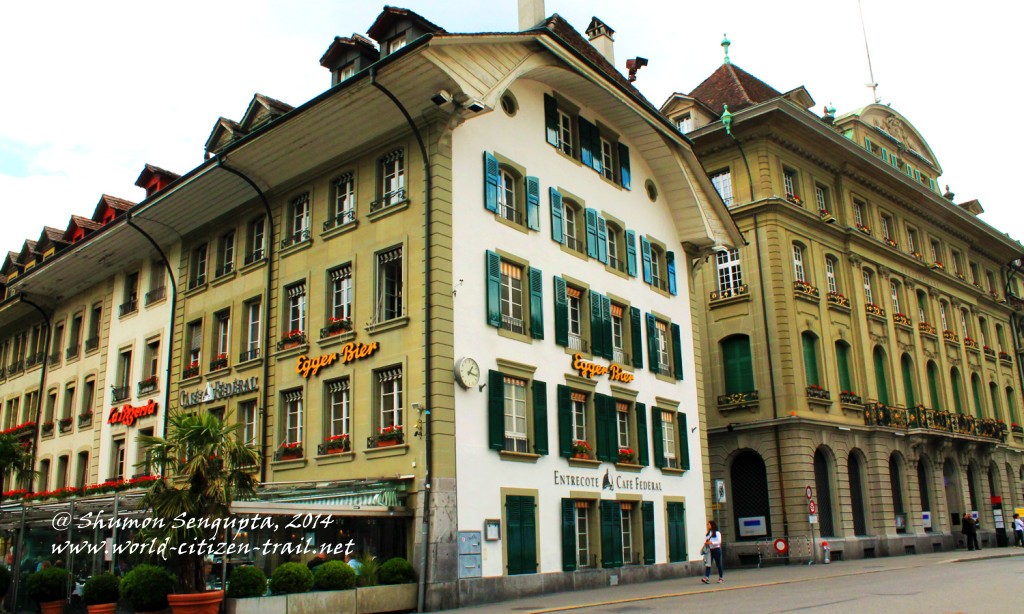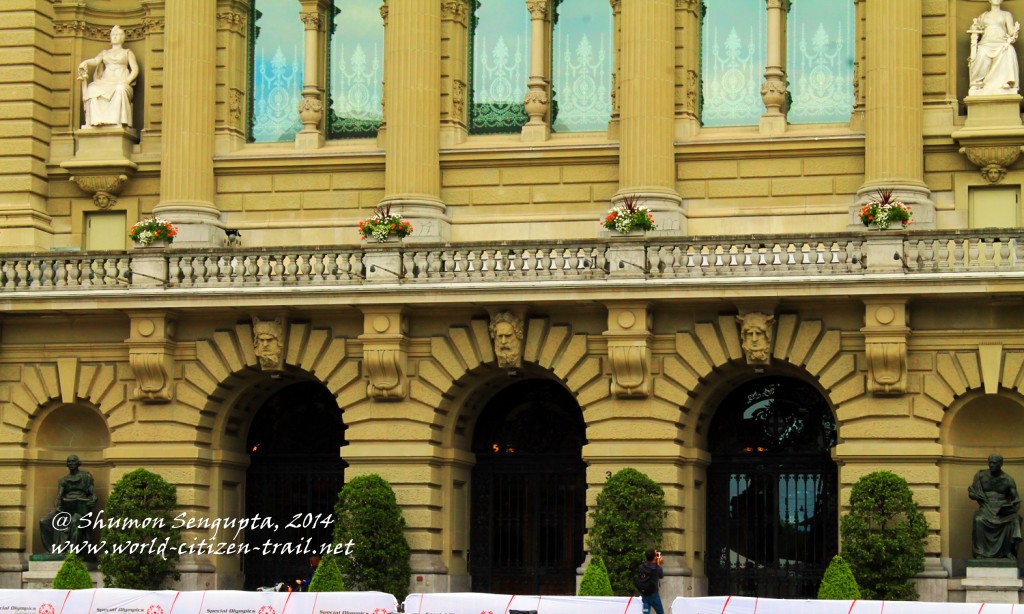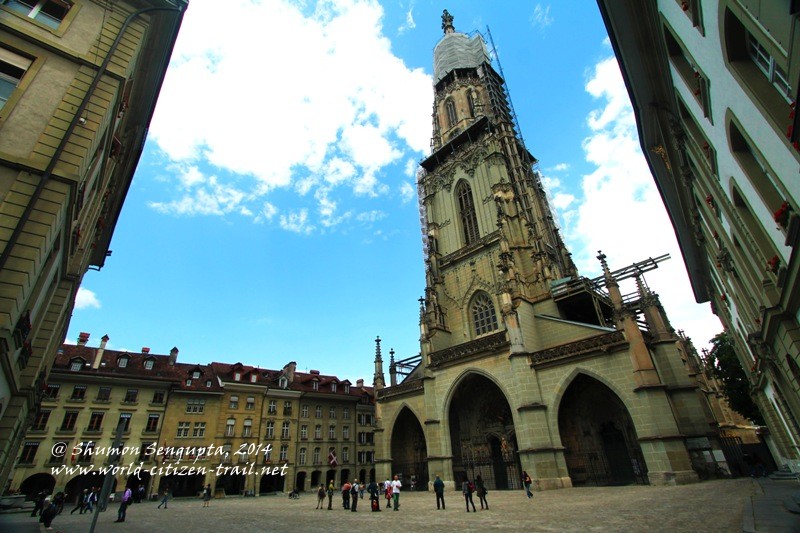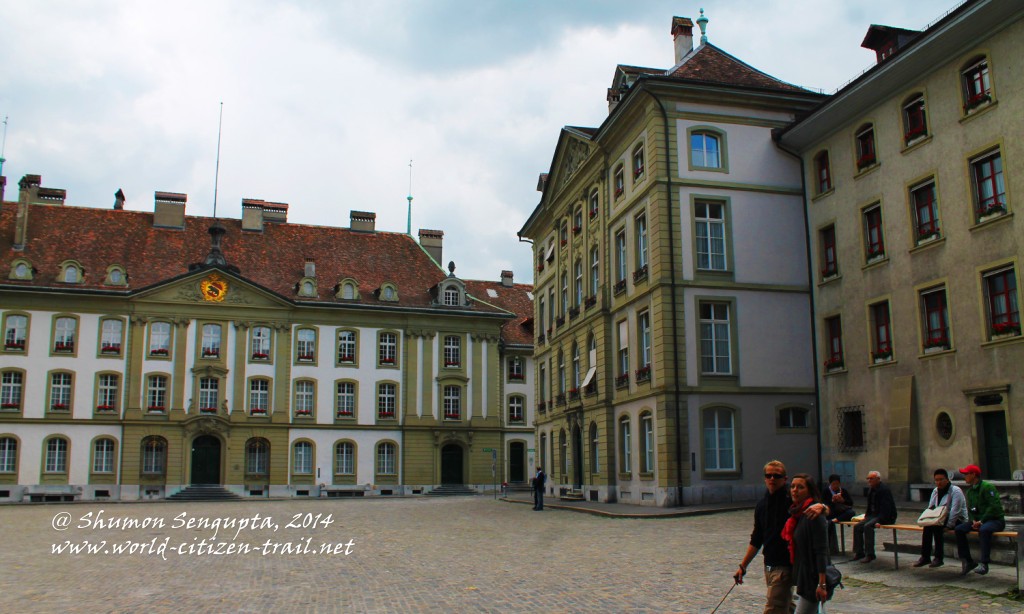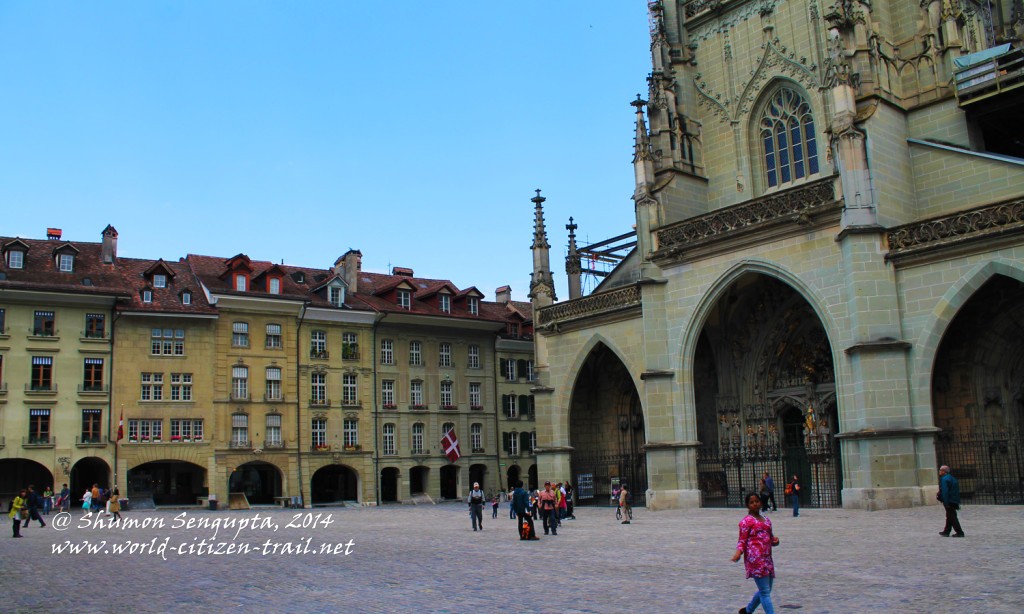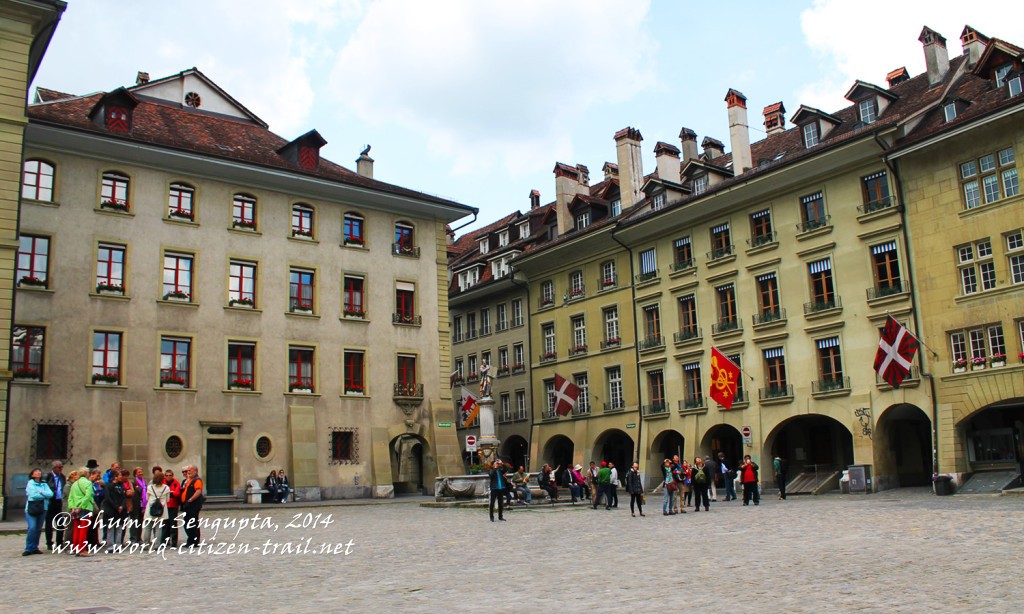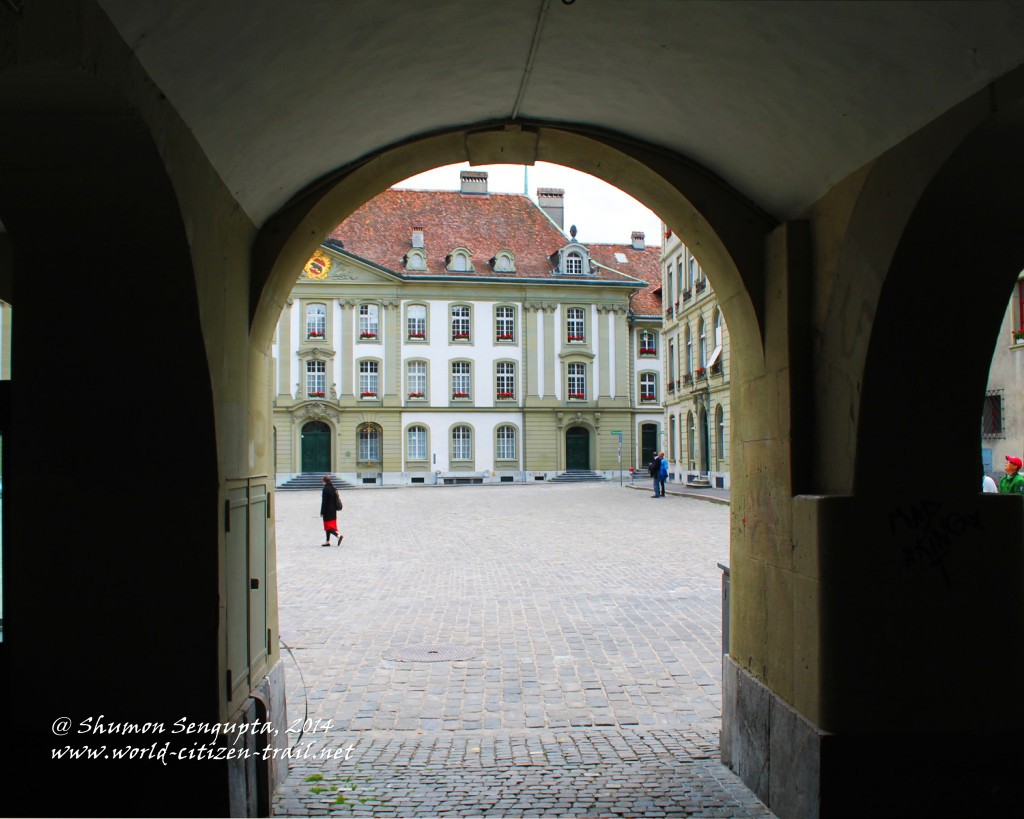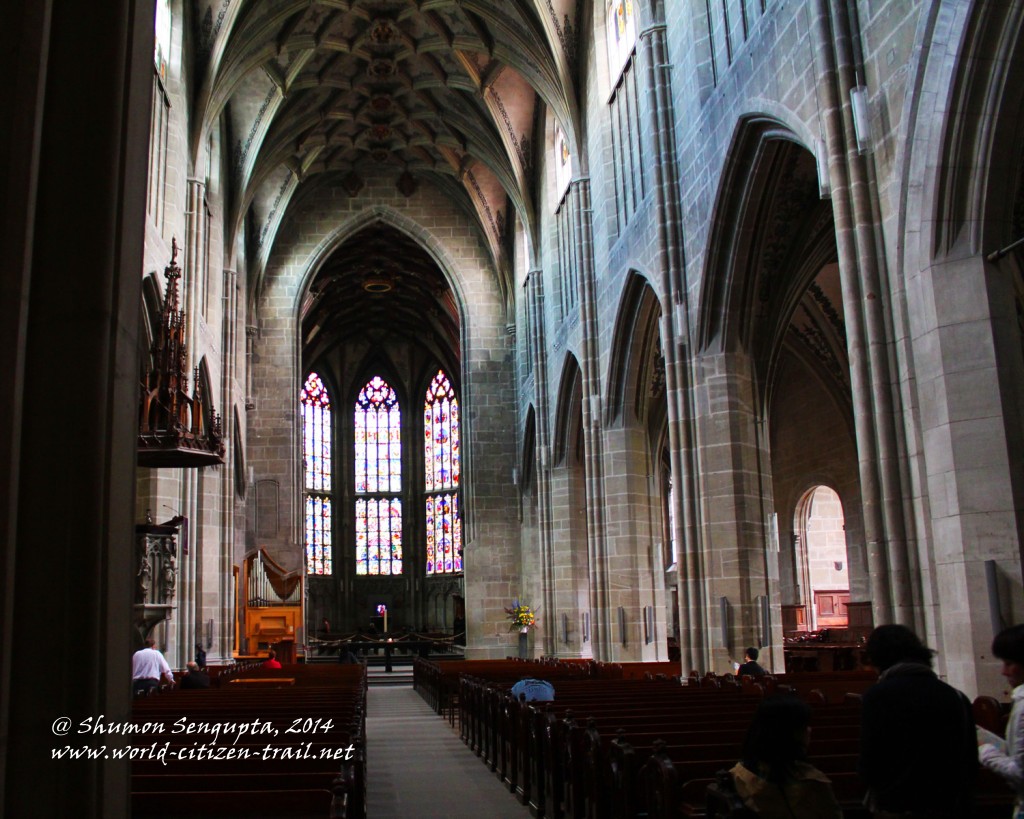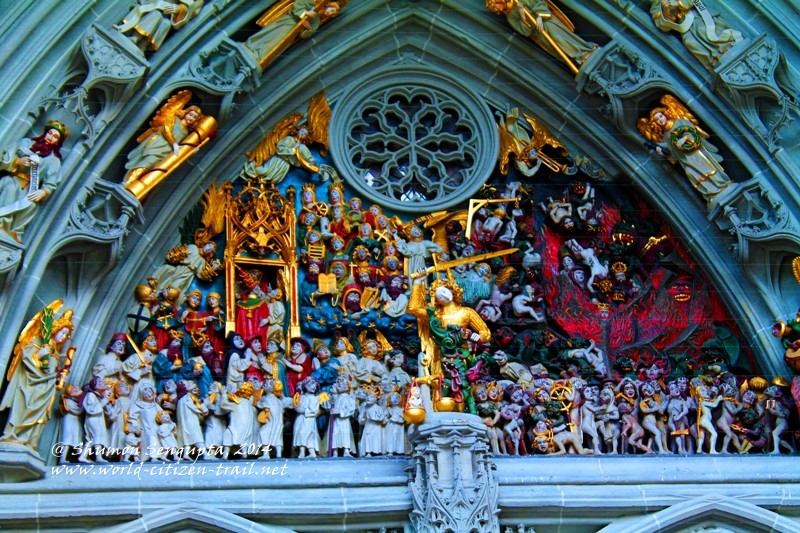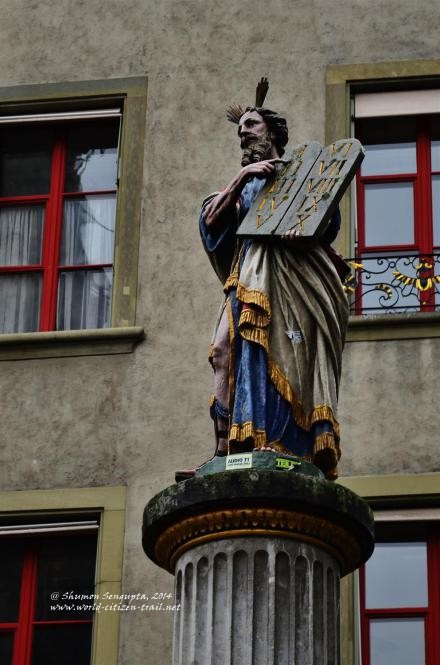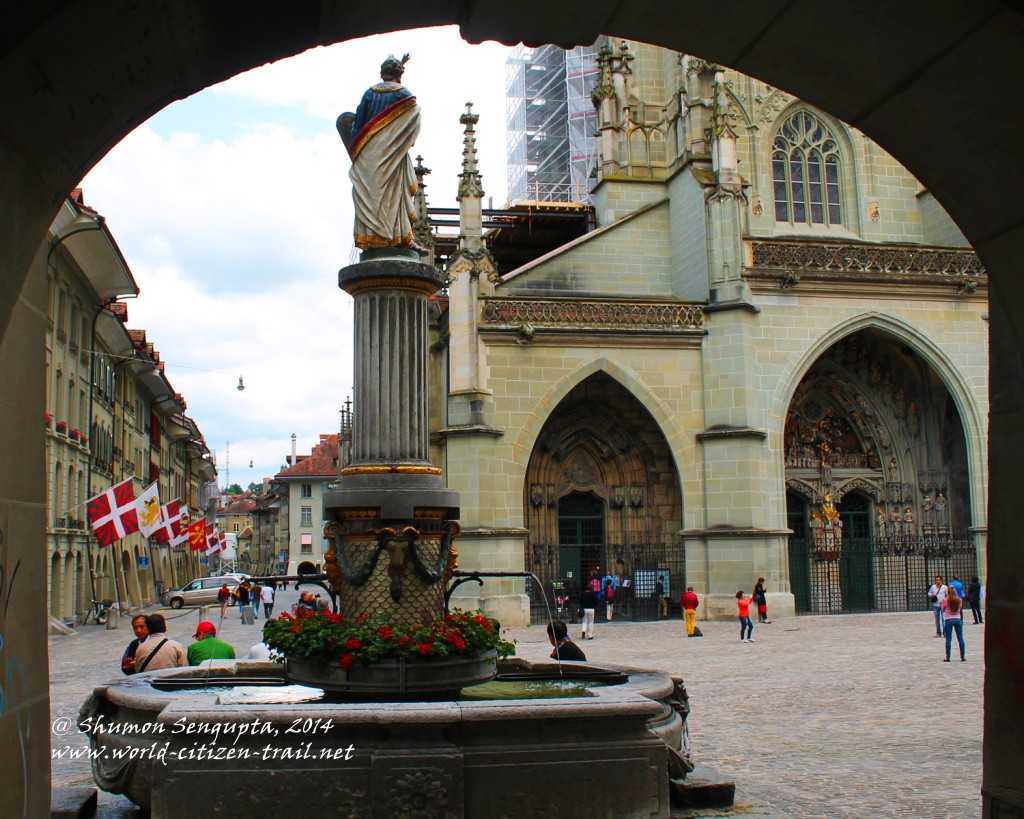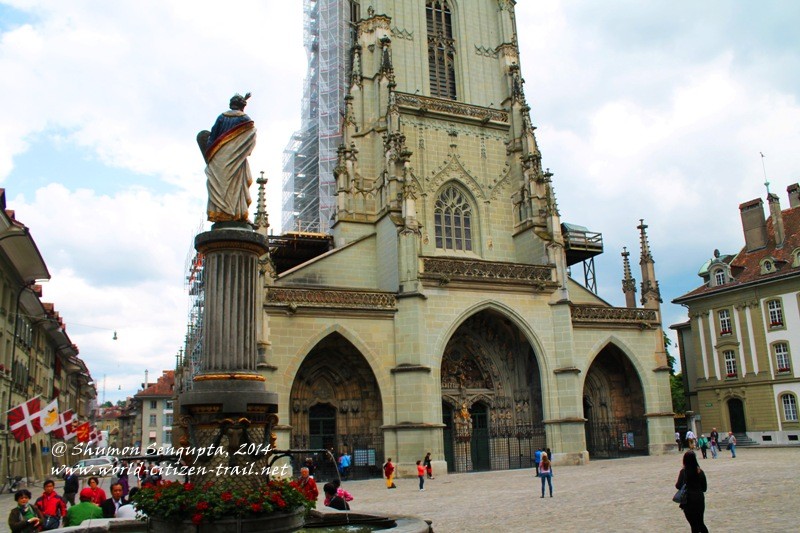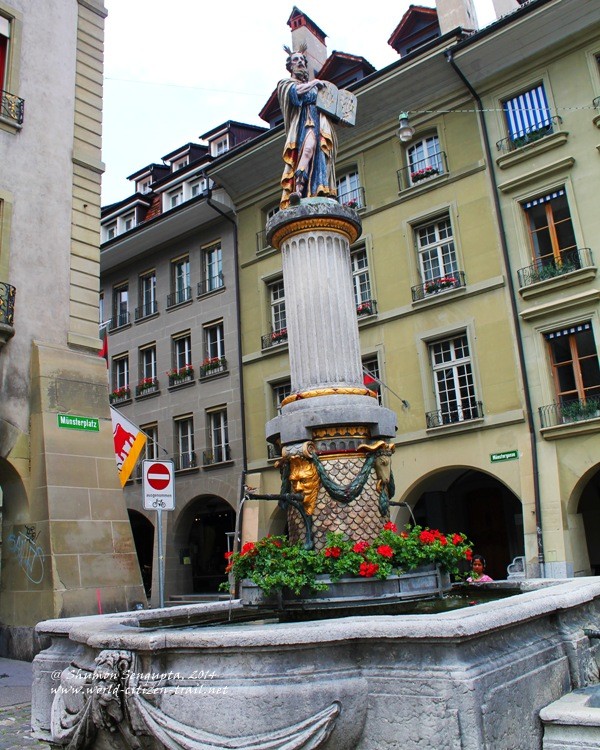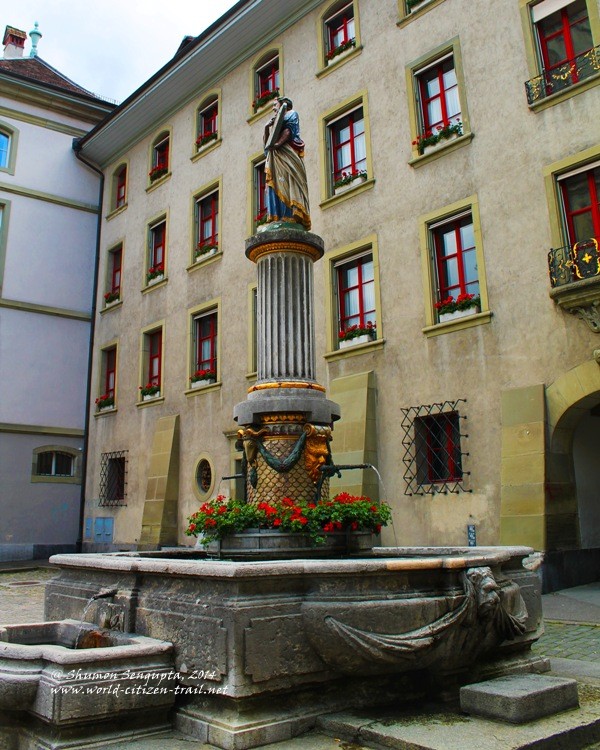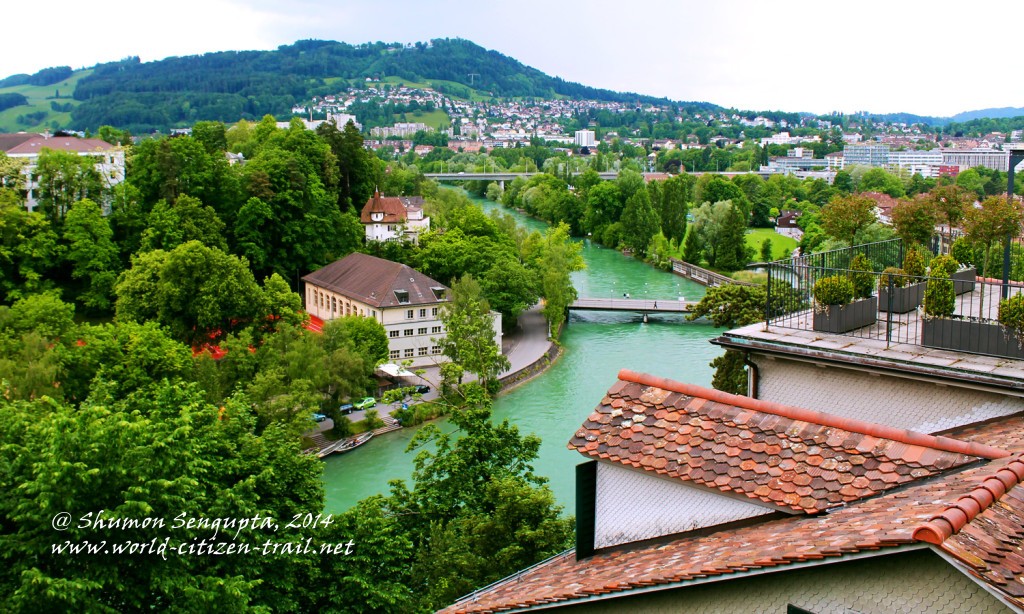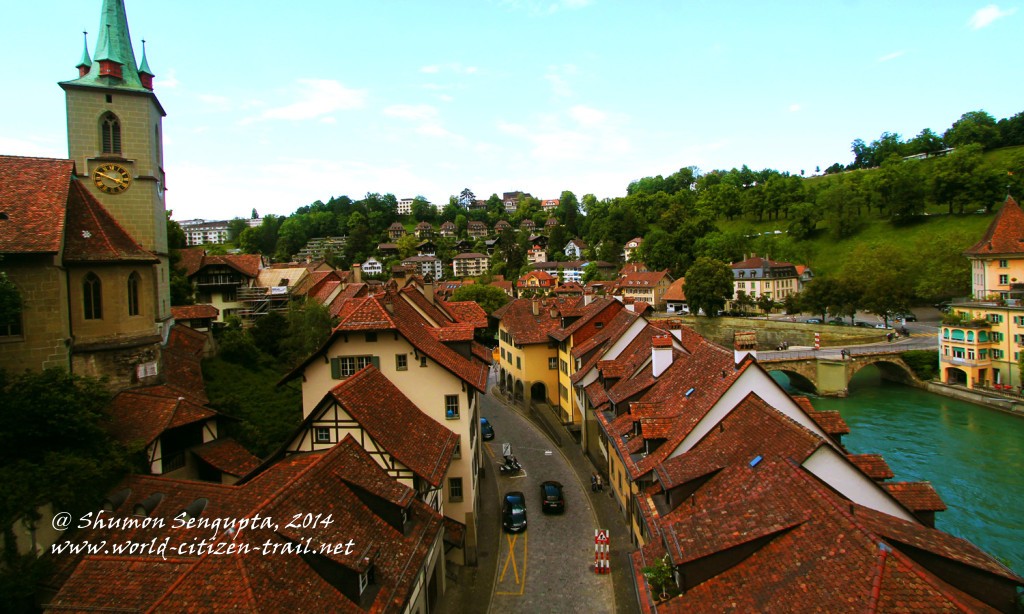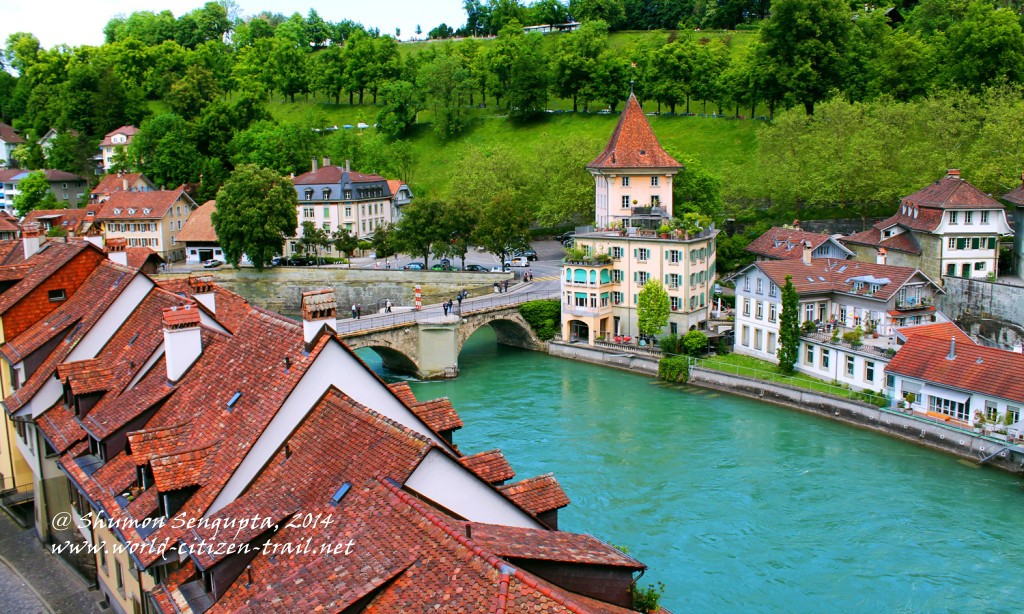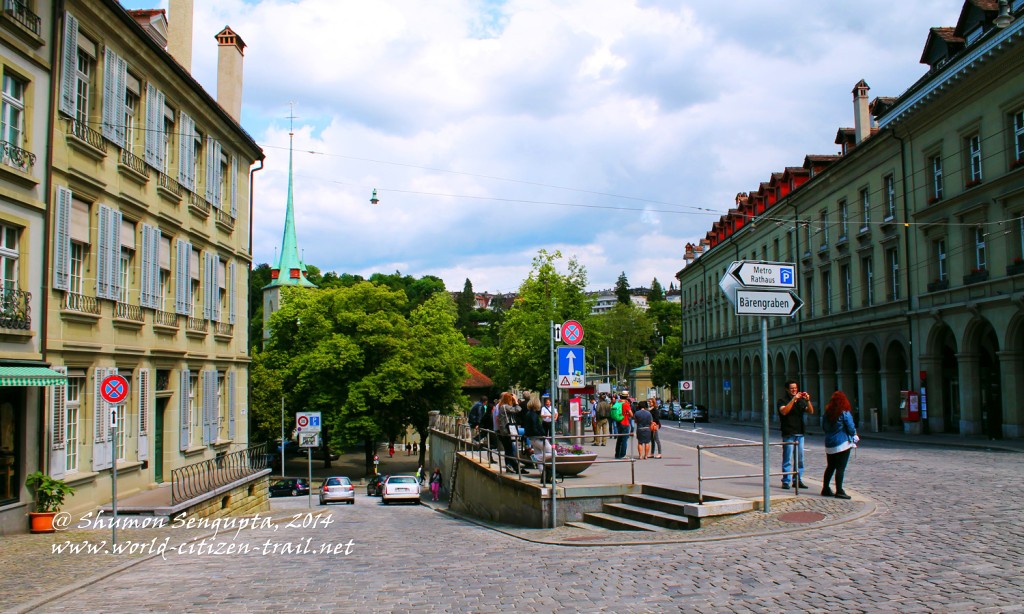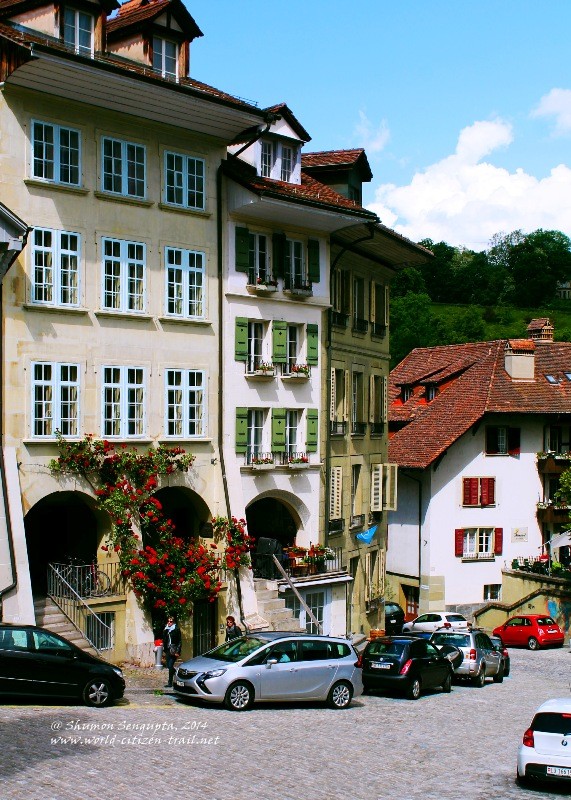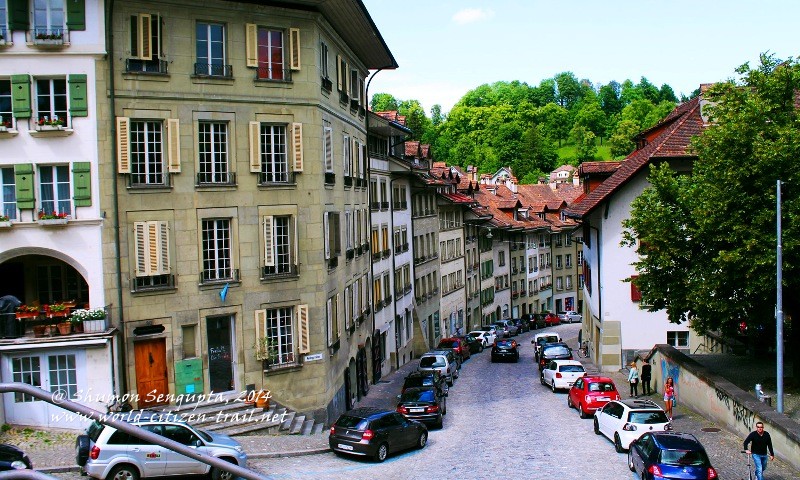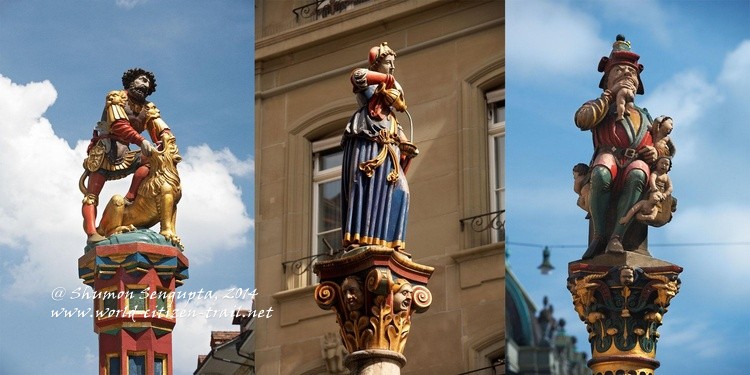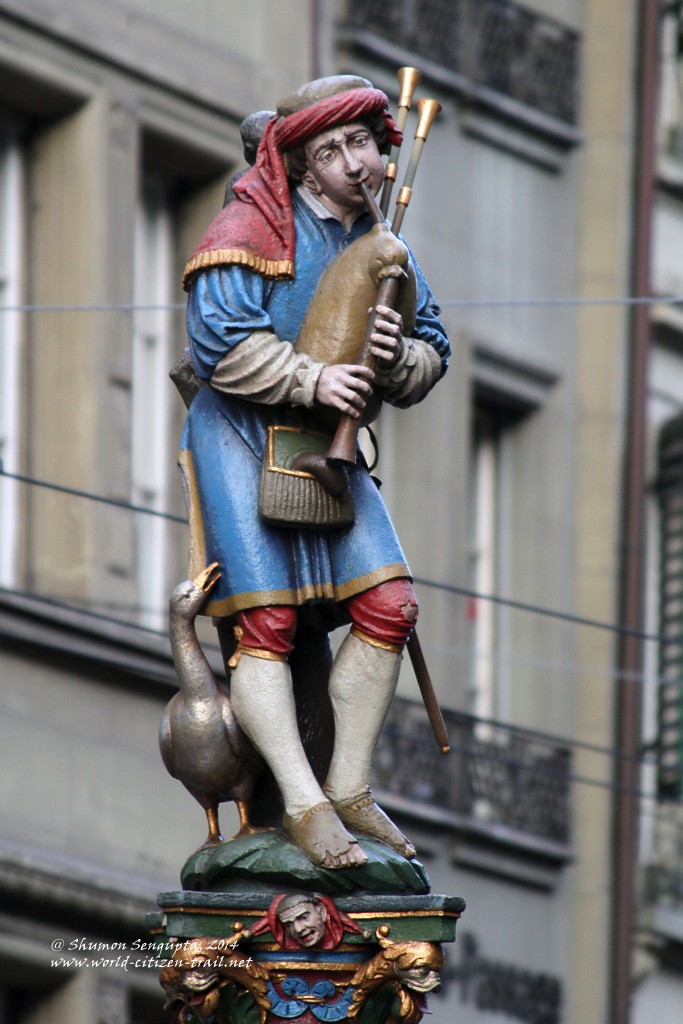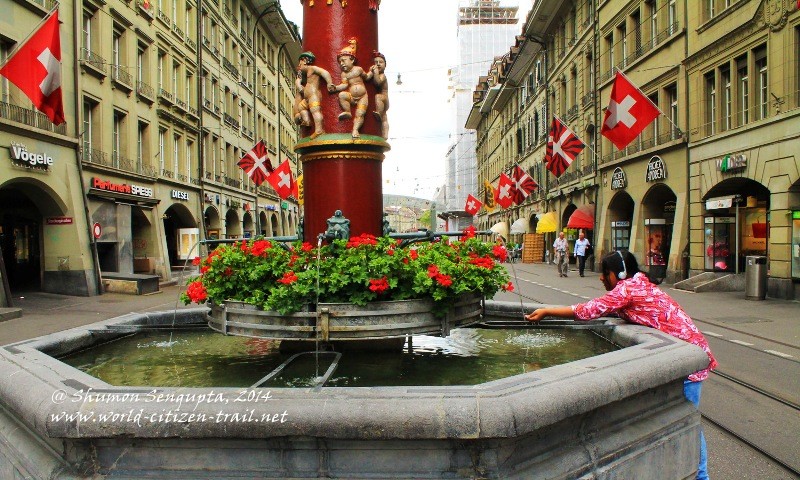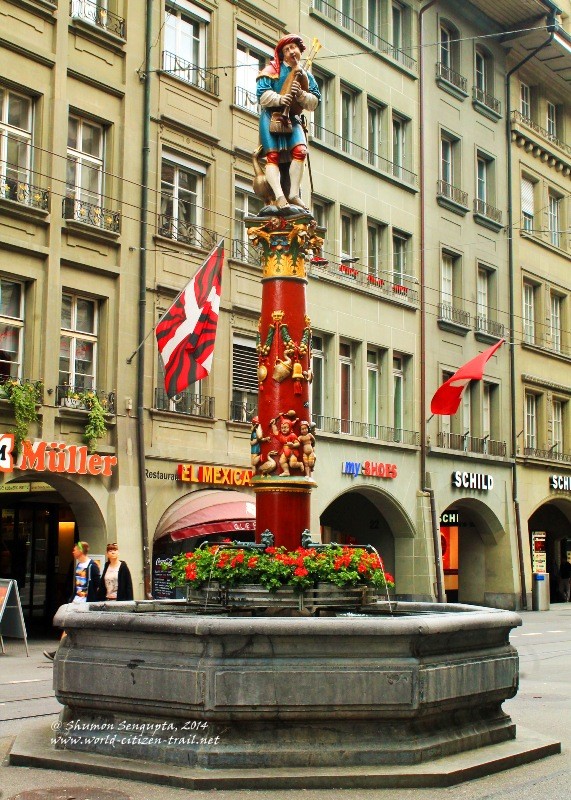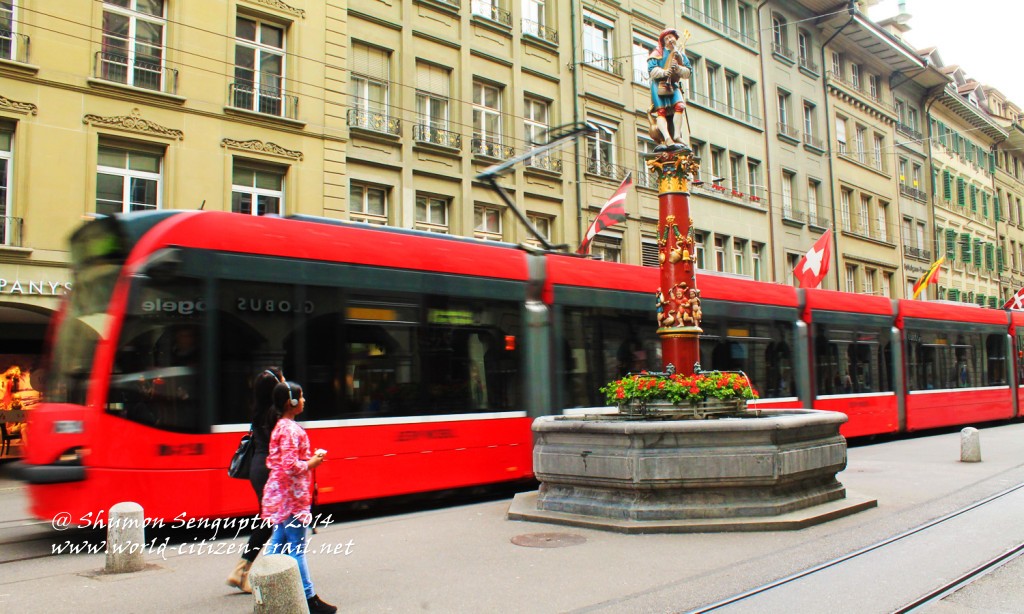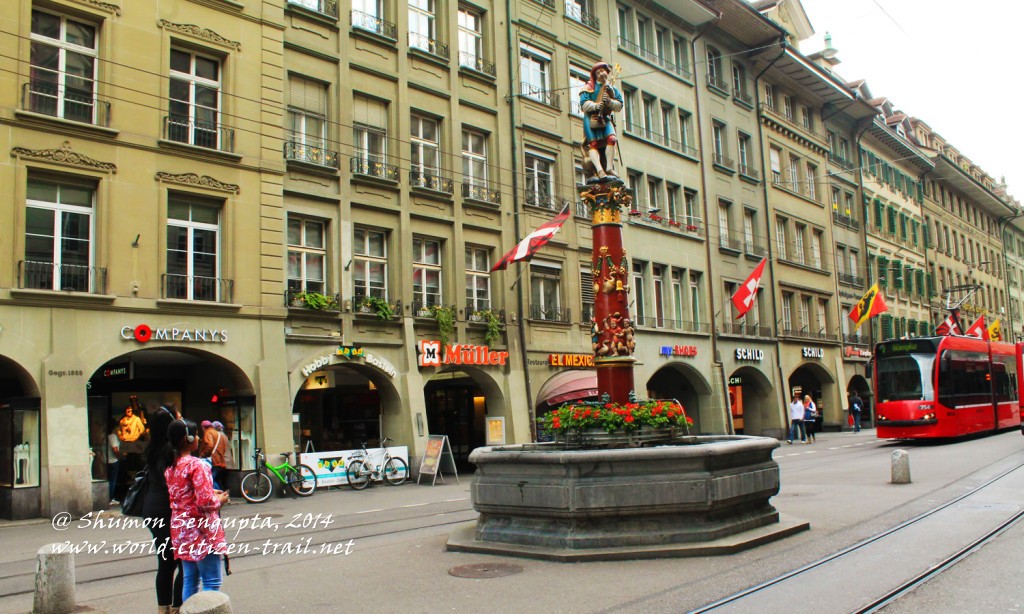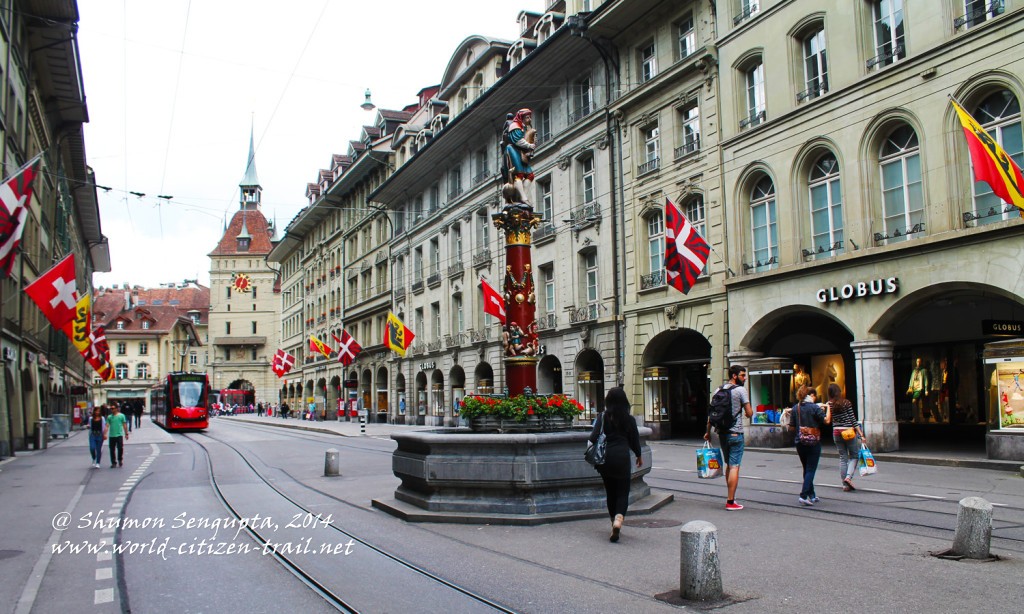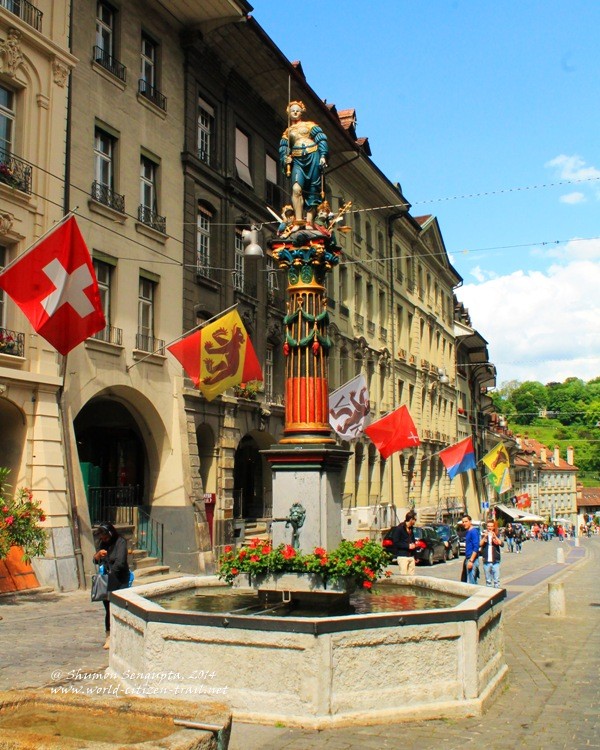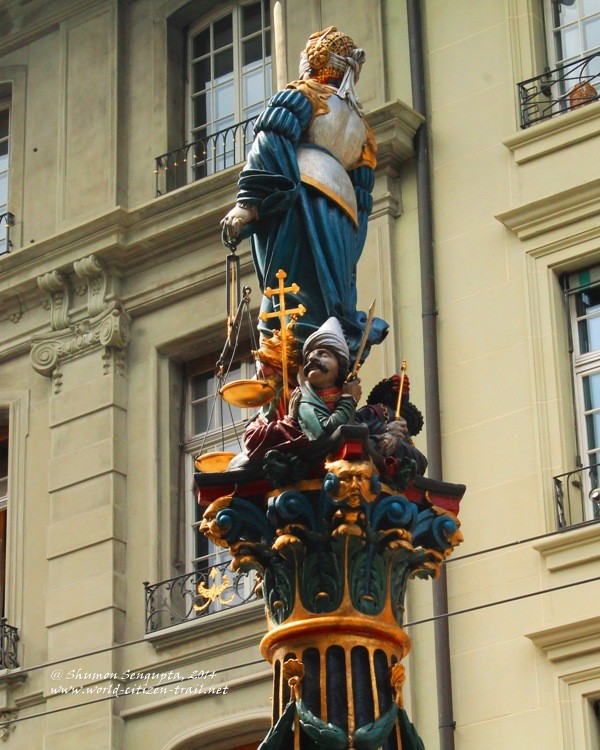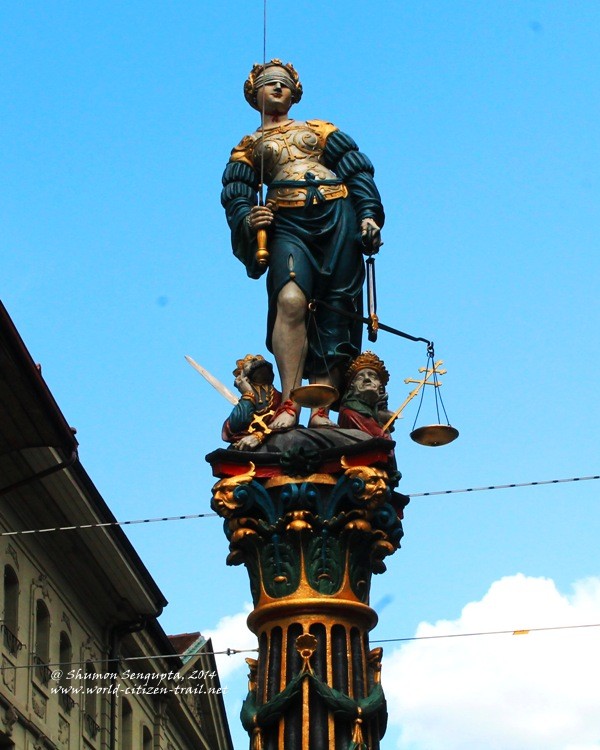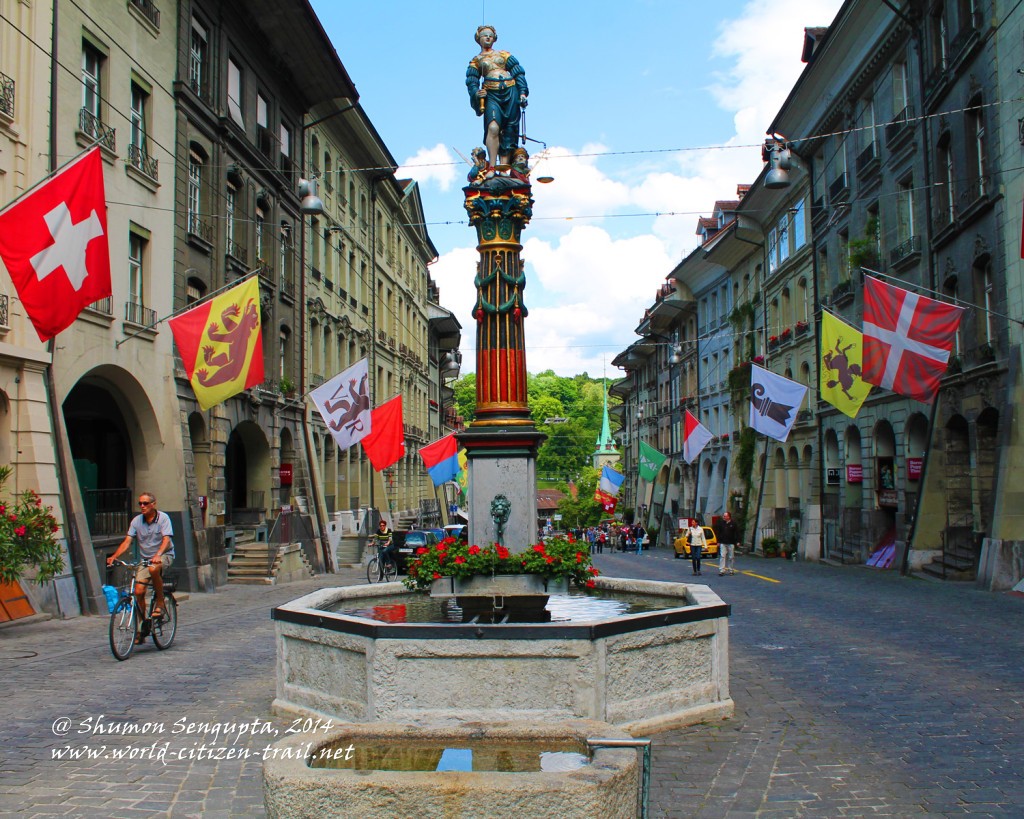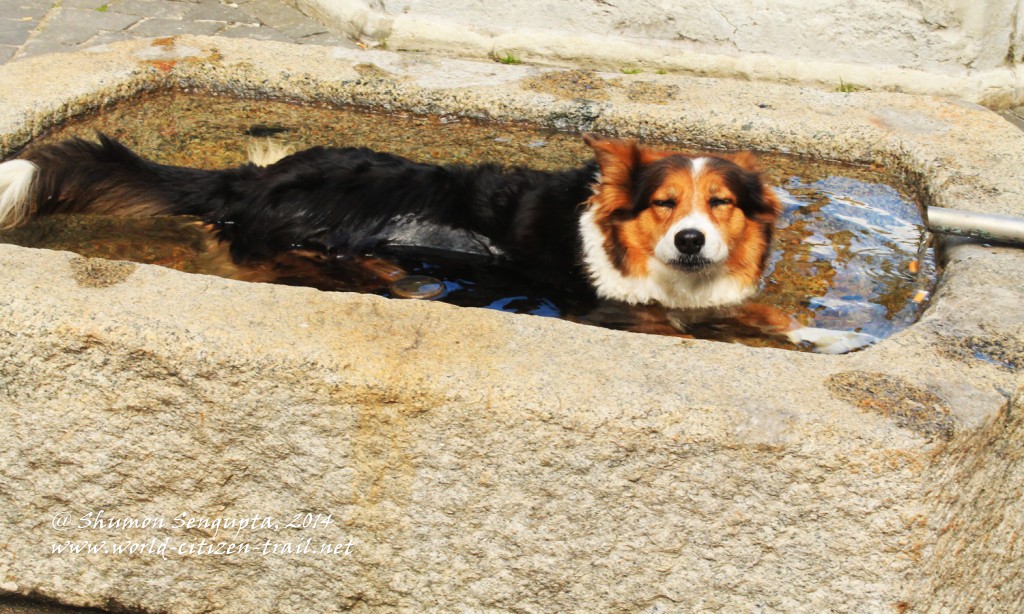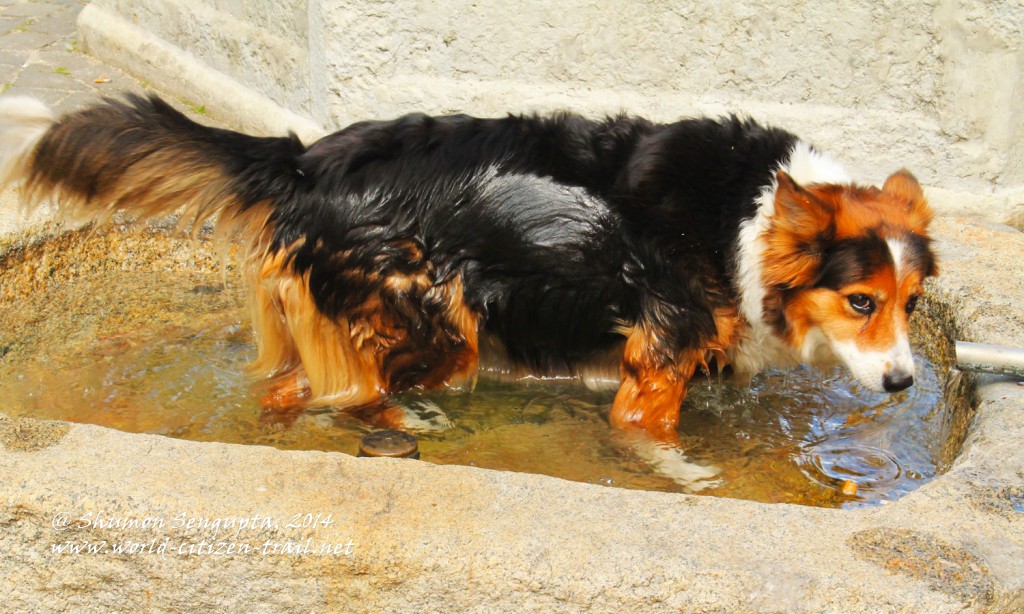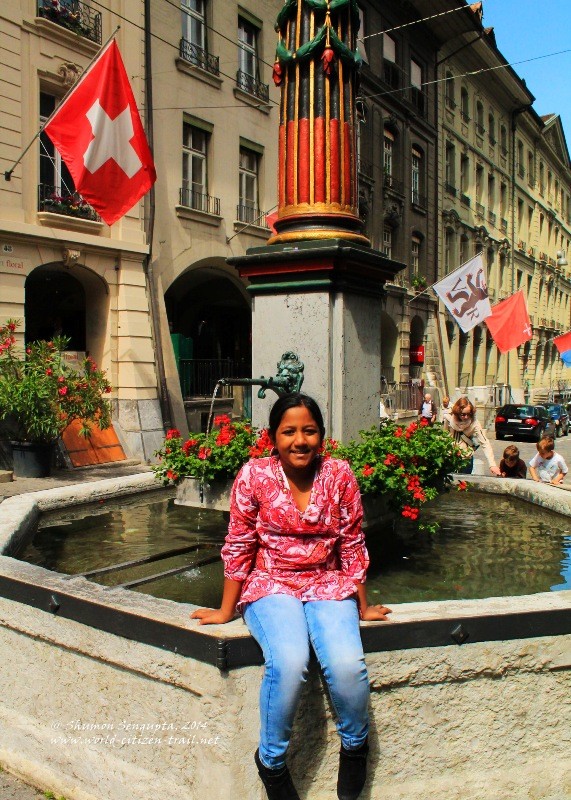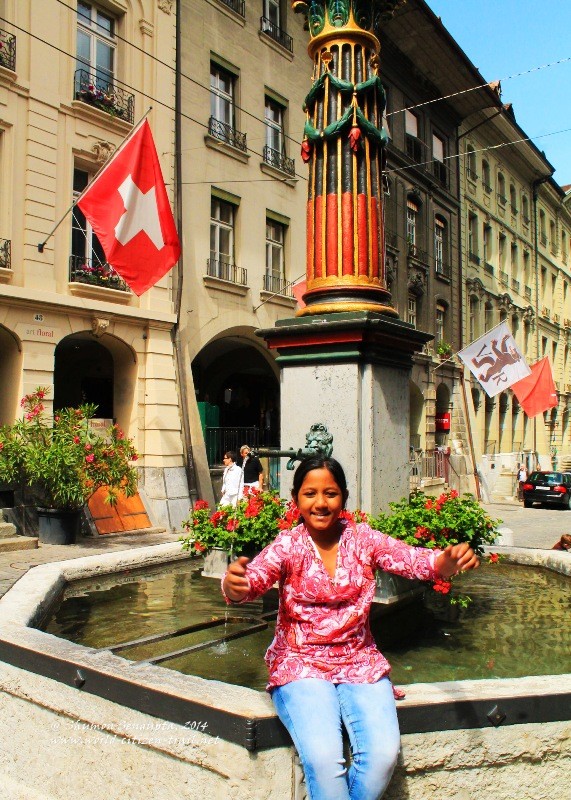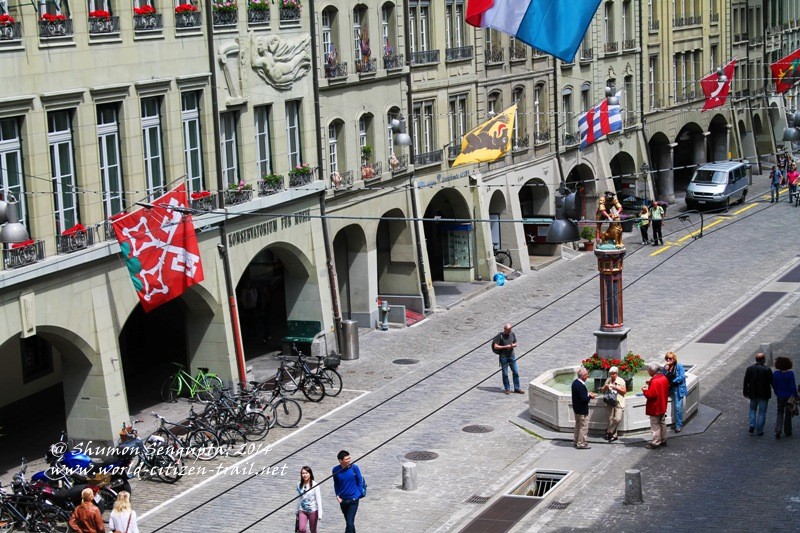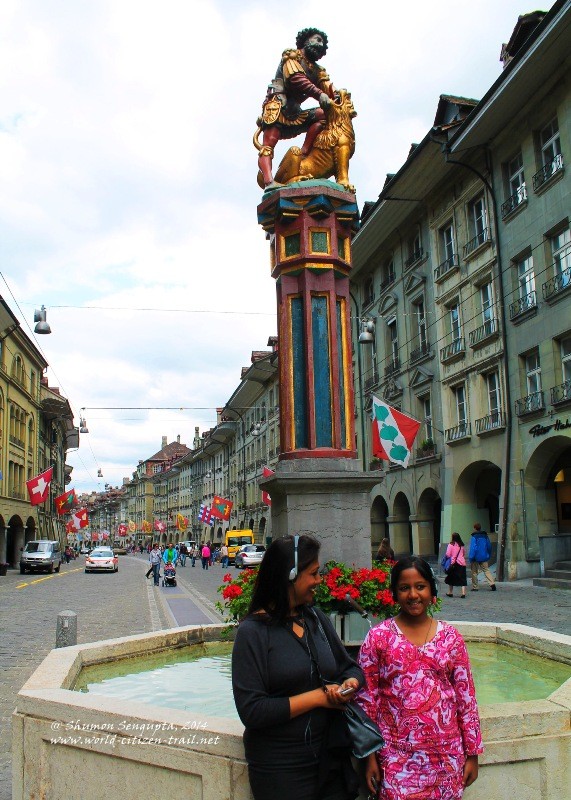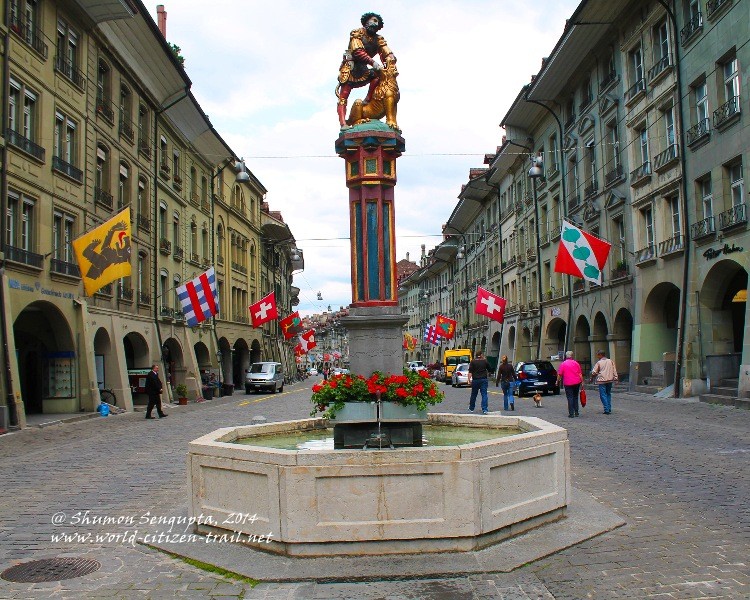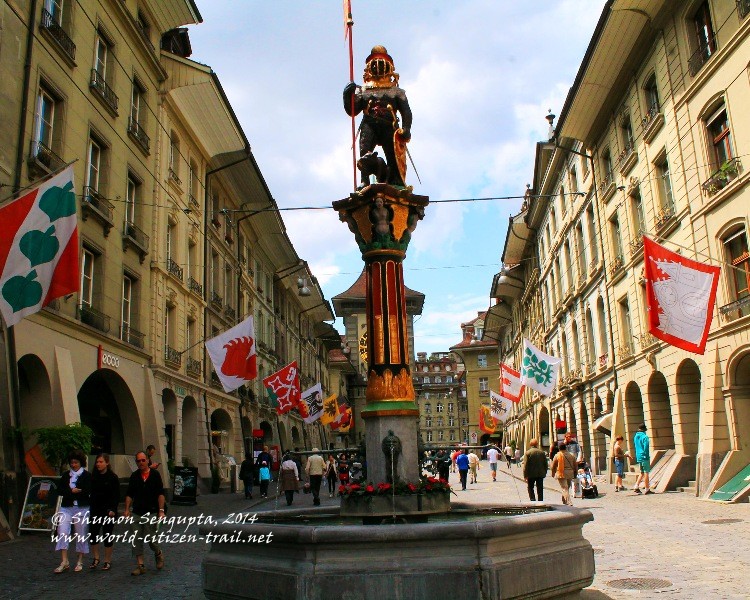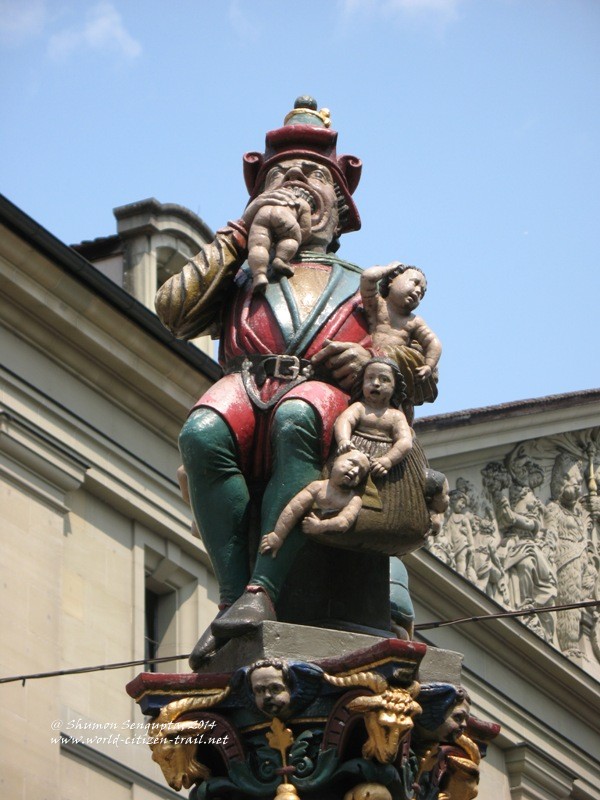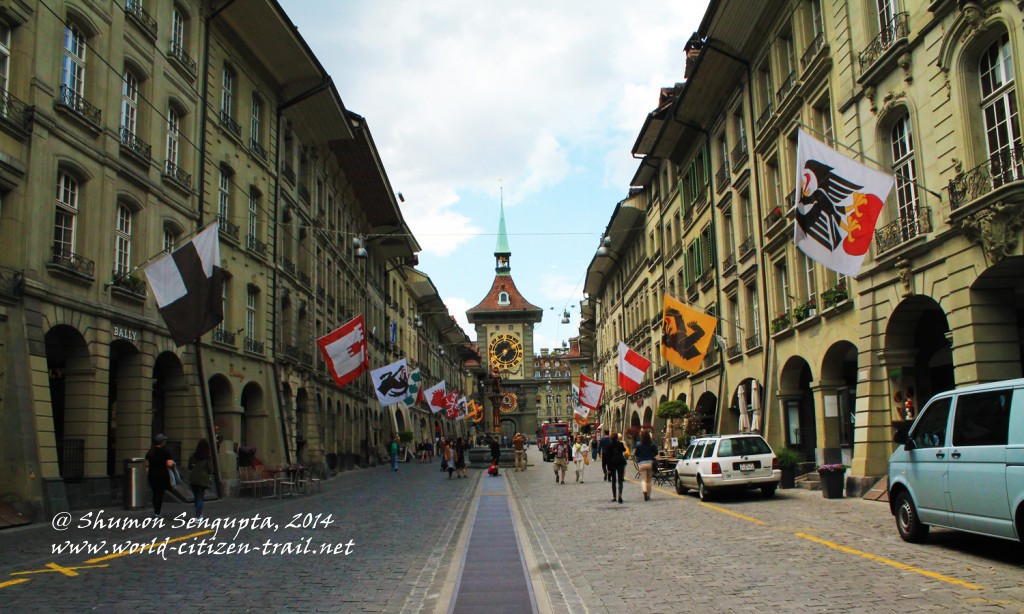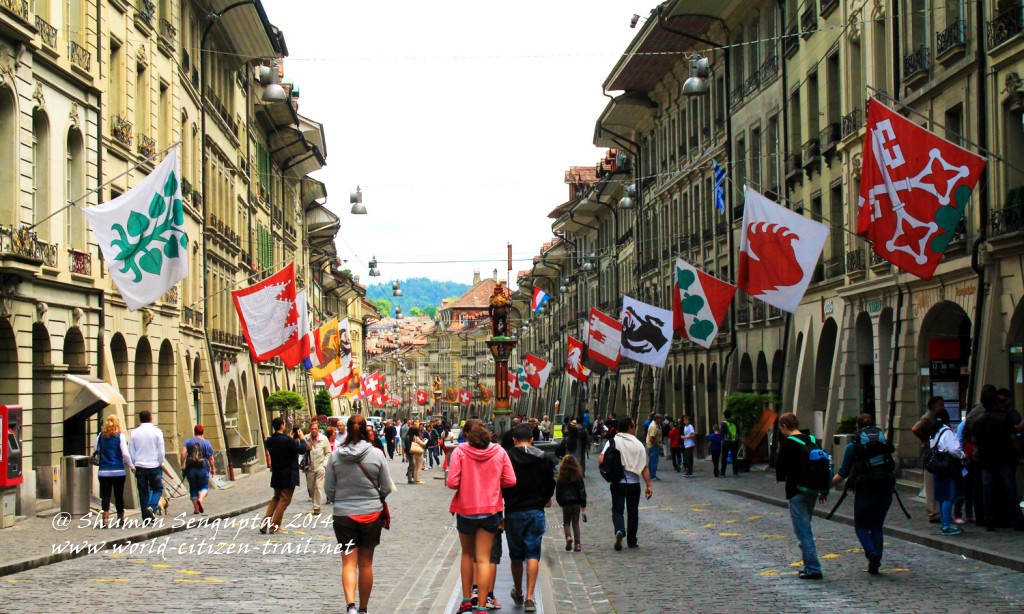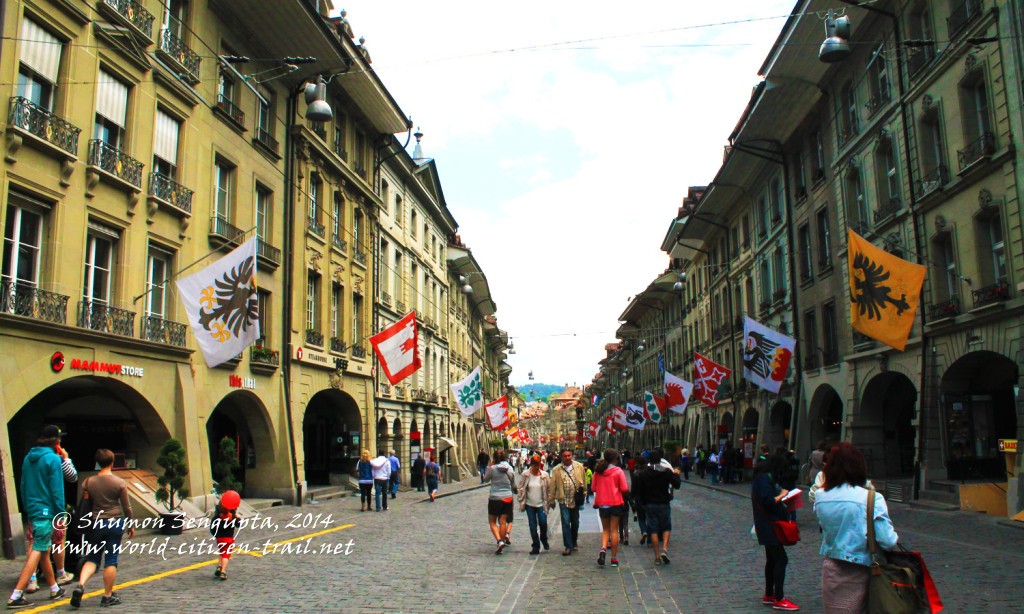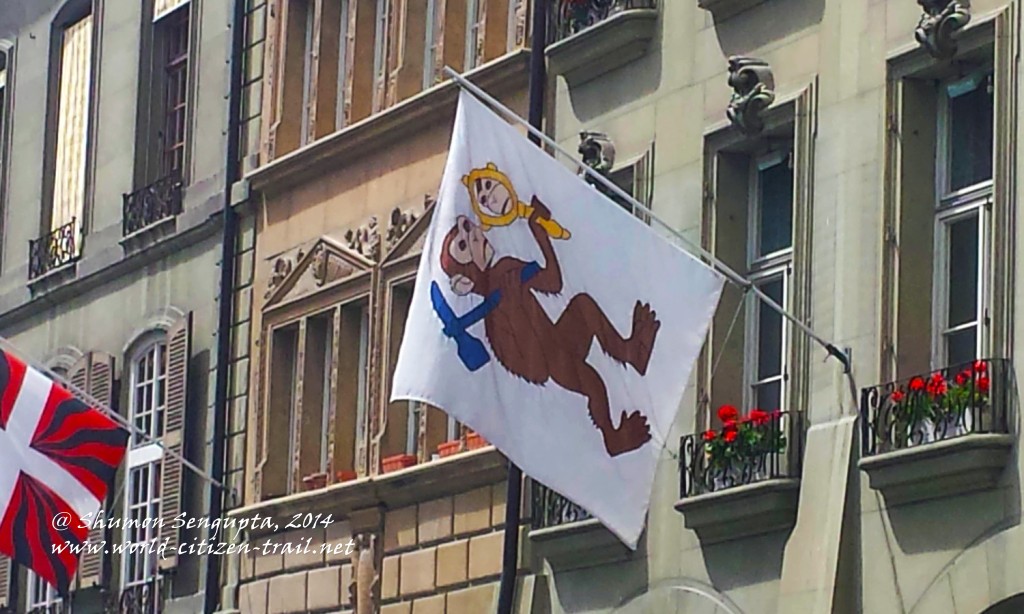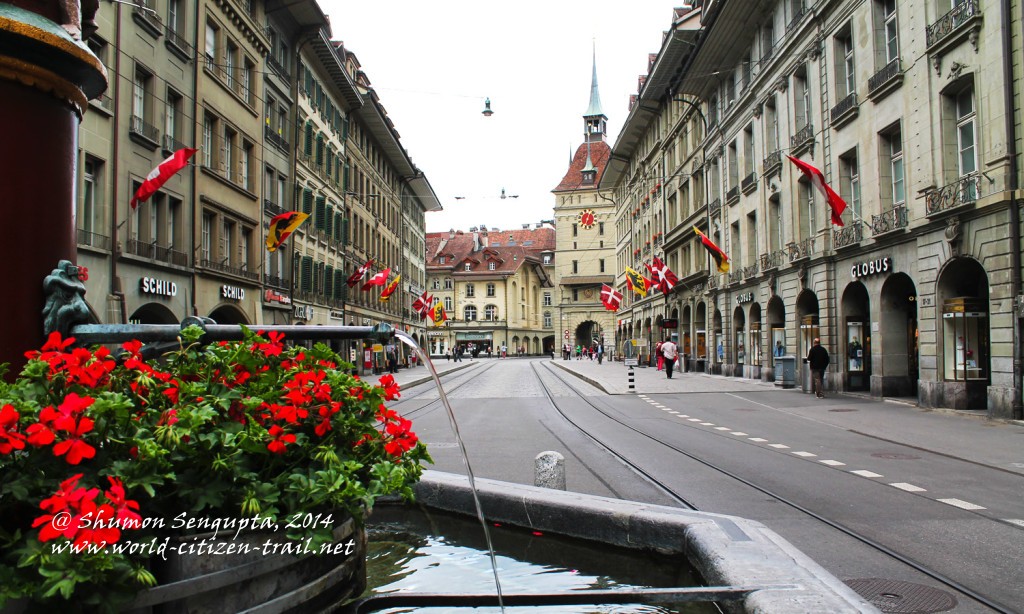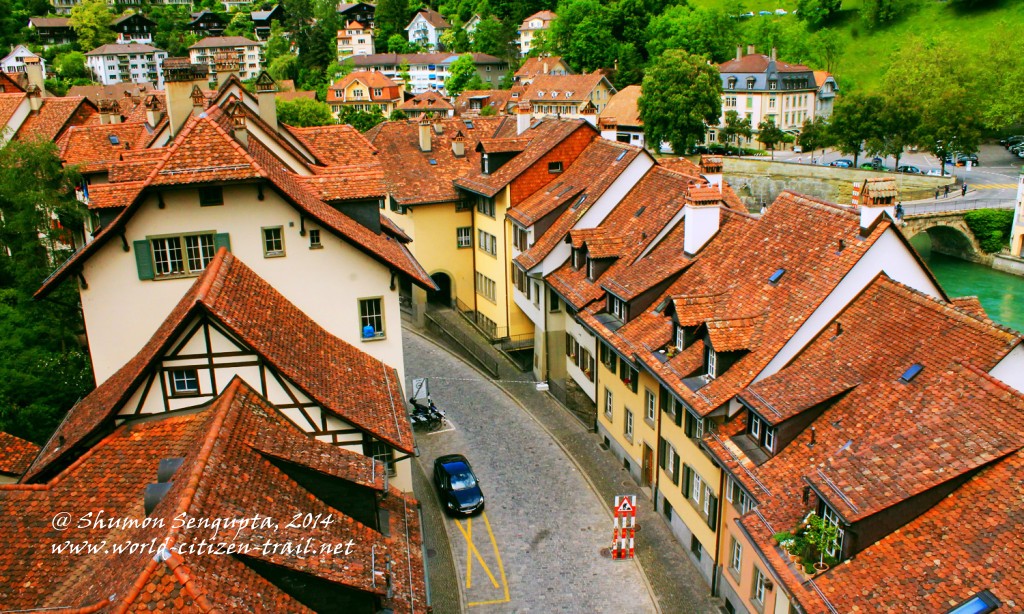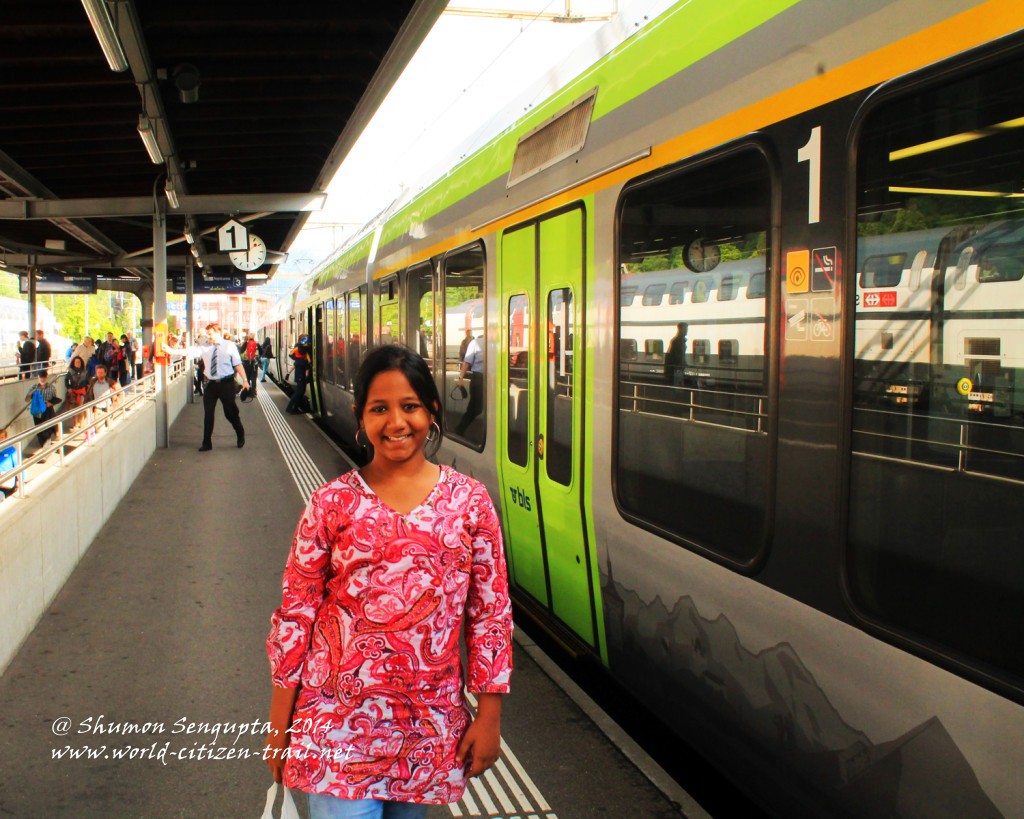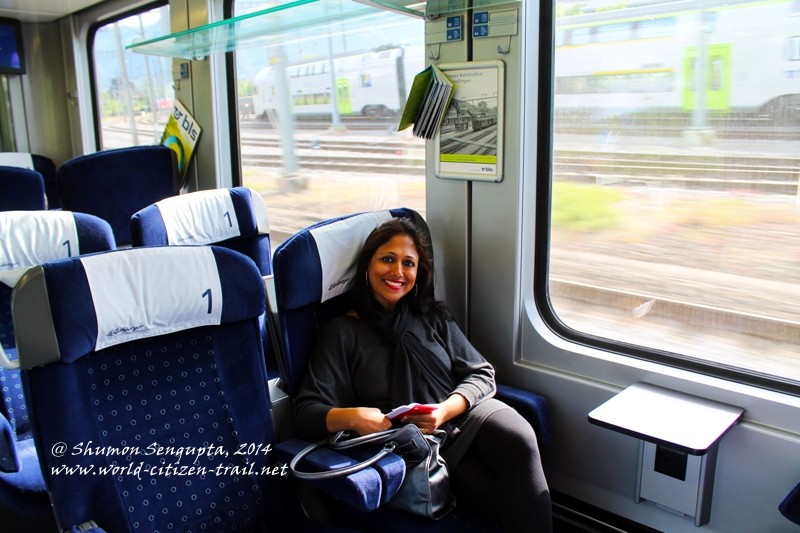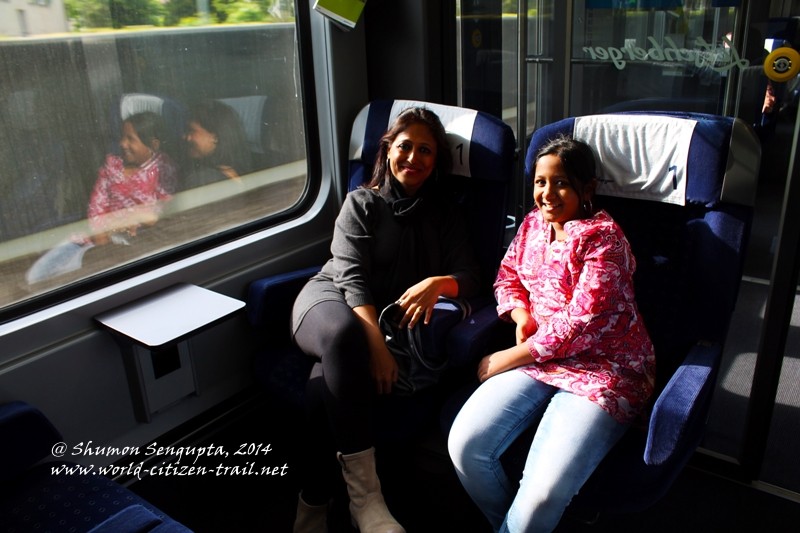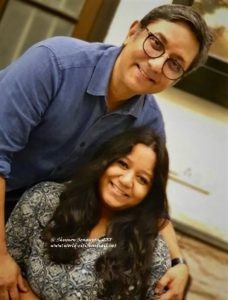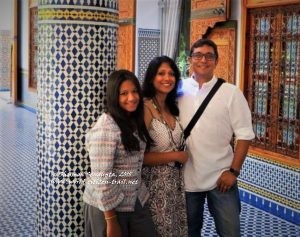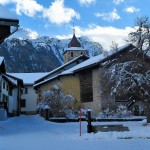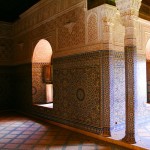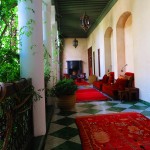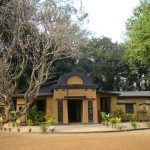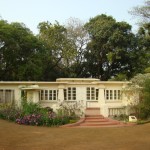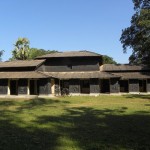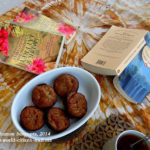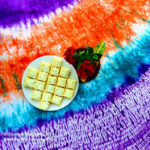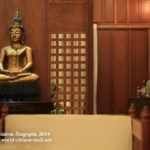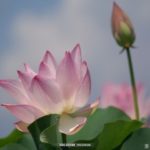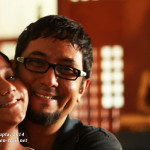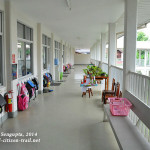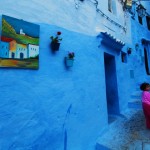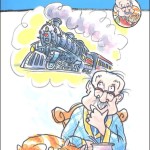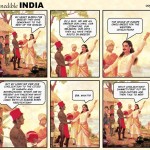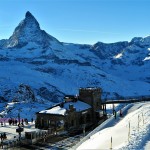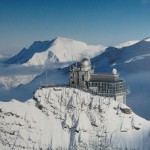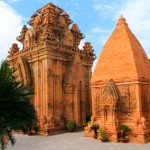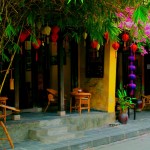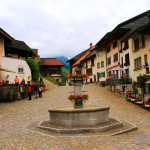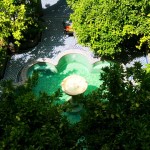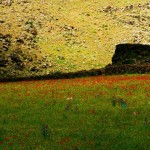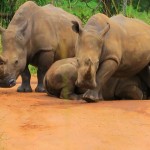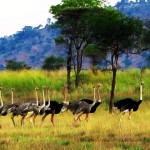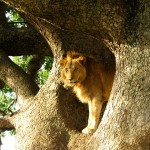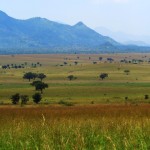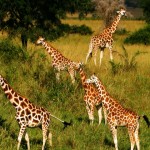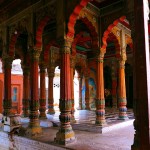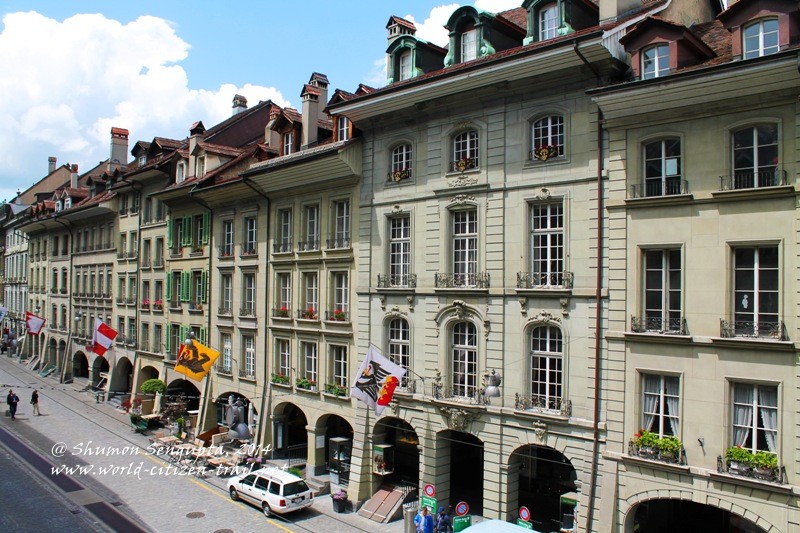
We visited Bern, the capital of Switzerland, on a day trip from Interlaken. Boardeing our train from Interlaken Ost in the morning, we passed through some beautiful scenery and reached Bern approximately one hour later.
Located on a plateau, the city is about 20 km north of the Bernese Alps. The Bern train station is located next to the historic center of the town.
On arriving at Bern, we went to the Tourism Office located on the upper level of the train station. From there, we picked up three iPods for a self guided tour of this fascinating city. Despite being the capital of Switzerland, Bern is a fairly small city, the fourth largest in the country, with a population of about 140,000 people.
From the railway station, we walked down the main cobbled street into the old town center – towards the Zytglogge, or the medieval clock tower.
Built in 1530 (around the time of Akbar the Great in India), this impressive clock tower has two clocks – one a standard time clock and the second one (built below the time clock), an elaborate, colorful astronomical clock with moving puppets. The second clock represents the planets orbiting the sun. It continues to work even after 500 years since it was constructed.
Every hour, the clock comes alive with the bell in an extraordinary display of mechanical puppetry. About five minutes before the hour bell, a rooster on the right hand side of the clock flaps its wings and calls out. A minute after that, a jester who sits at the top on the left hand side of the clock rings the two small bells above him, accompanied with a circular procession of mechanical bears (the mascot of the city). And then at the dot of the hour, old bearded man – Father Time, seated on a chair below the jester turns an hour glass held on his right hand and gestures with his staff on his left hand, as the bigger bell gongs to the number of hours, as per the hour of the day.
The old part of the town is said to have been founded as early as 1191 CE. As a result of a devastating fire in 1405 the wooden buildings were burnt down. After that, the entire city was rebuilt of pale gray lime stone, in a well planned and harmonious manner, in the medieval architectural style. Because limestone is relatively porous all buildings have uniformly large size eves to protect the walls from water. This lends an element of architectural distinction and integrity to the old town of Bern.
About 6 km of the side walk along the streets are arcaded. These covered arcades evolved from the middle ages when artisans and craftsmen exhibited their good on the sidewalks, under temporary roofs or sheds. As the town was rebuilt in stone after the devastating fire and the new buildings built as per strict plans, the street side shops and stalls were expanded and converted into arcades. The arcades are privately owned and owners are required to keep them clean and allow unhindered public access. So you can pretty much move in the old town, under the cover of arcades, which now host shops, cafes and restaurants. The old town of Bern boasts of one of the one of the longest covered shopping promenades in Europe.
We meandered along the old town, guided by our iPods. Apart from the beautiful buildings with Baroque facades, we were fascinated by the countless flags festooned to the buildings on the side and the spectacular renaissance fountains along the middle of the main street. The facades of the buildings also had colorful sculptures over the street level.
We then went to the square (the Bärenplatz) in front of the Swiss House of Parliament (The Bundeshaus, or the Federal Palace), surrounded by the headquarters of some of the famous Swiss banks. The beautifully redesigned and renovated square is used for Bern’s traditional weekly fruit, vegetable and flower markets twice a week, for cultural events, official receptions, political rallies and sporting events and as a public gathering place in general. There is a new water display in front of the Parliament building with 26 fountains, representing the cantons of Switzerland, including few of its “half cantons”.
The Bundeshaus, or the Parliament Building was built from the 1852 and 1902 and was decorated by 38 artists from all over the country. A part of this beautiful building is open to visitors. This interesting and beautiful building has statues of three women at the top. The woman at the center represents political independence, while the one on the right stands for peace and the one at the left, for freedom. It was fascinating to see that values that we hold so dear in modern progressive societies were all depicted by women.
We then took the Junkerngasse street, along the palatial old buildings (some dating back to the 1400 CE) and the seat of the Government of Bern (an old palace, converted into a government building), through to the Munsterplatz and the gothic cathedral, known as Das Berner Münster.
Built over a period of time starting from 1421, construction of this cathedral continued for several generations under different builders. At 328 feet, the spire (completed as late as 1893) is the tallest in Switzerland. There is a vantage point, 244 steps up the spire above the entrance which provides spectacular views of the old town and on a clear day, the snow capped Bernese Oberland at a distance as well. The cathedral is a notable structure in the old town and dominates its overall architectural feature.
Sadly, when we went, a large part of the upper section was covered for renovation. The cathedral has three naves and is 85 meters long and 34 meters wide, with an imposing organ. Everything is very impressive in scale. The interiors are elaborate and ornate, with a spectacularly beautiful stained glass panel. The external walls are supported by flying buttresses.
The portal at the center of the exterior of the cathedral has a fascinatingly graphic and colorful depiction of the Last Judgment. On the left hand side are the virtuous ones in white, enjoying the blessings of heaven and on the right hand side are the sinful ones, burning in hell for all possible conceivable “sins” and transgressions. Interestingly, a king (along with his crown) is shown burning in hell, and this serves as a warning that even the powerful and the mighty are not spared of their misdeeds in the Last Judgment.
The depiction of Hell was far more graphic and interesting than that of Heaven and one can spend hours gazing at it and deciphering the message conveyed by the iconography.
And in front of the cathedral, on the Munsterplatz is the beautiful fountain of Moses, pointing his finger to the second of the Ten Commandments. The Second Commandment forbids idolatry, one of the fundamental principles of the Lutheran reforms in Switzerland.
From there, we strayed into the beautiful, narrow and curved cobbled street, the Brunngasse, lined with beautiful old historic buildings. We then went to the Kornhausplatz – a large and lively public square, built around six centuries back. It used to house a granary in the 1700s and the plaza used to serve as a grain market – hence the name. The granary is now gone and there is a big restaurant in its place. 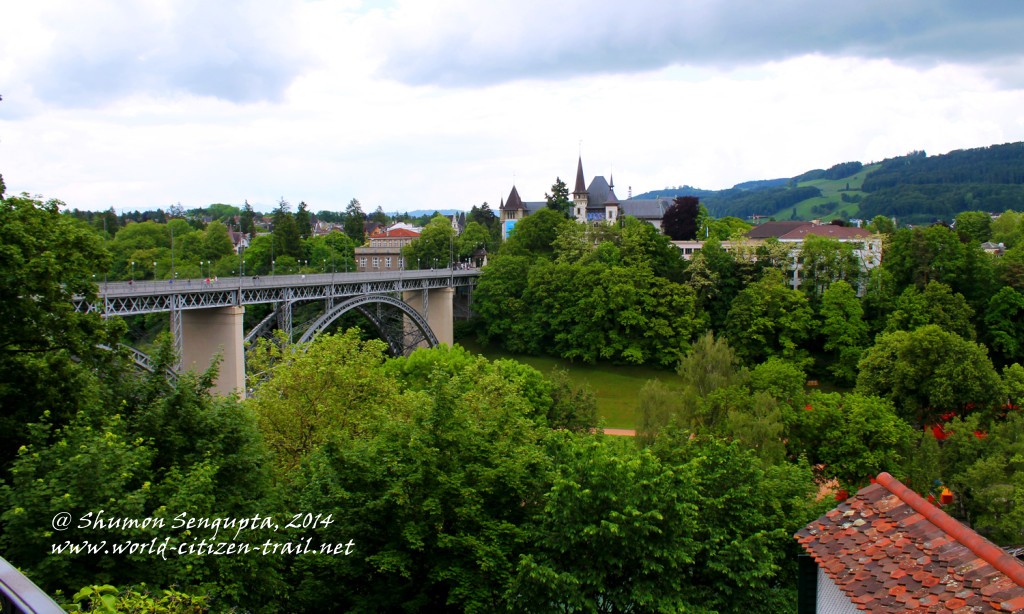
We then walked to the Rathaus (Town Hall) and another beautiful church, the church of St. Peter and St. Paul. From there, we went towards the Aare River, past the Bear Pit / open air Zoo on to the arched Nydegg Bridge. From the Nydegg Bridge, we got a beautiful perspective of the old town wrapped by the loop of the Aare River, the closely packed tile roof buildings and the old stone bridge further ahead of us. The Aare River looked emerald-green, probably because mineral content brought with the glacial water from the Bernese Apps. Bern’s Bear Pit is located immediately across the Nydegg Bridge.
On our way back, we went past the Zeughausgase with its square, fountain and up-market hotels, restaurants and cafes.
And finally, on our way back, we walked along the Kramgasse – a beautiful street in the old town, lined with old limestone buildings some of whose facades date back to the 15th century. The houses of some of the oldest Guild Societies are located on this street, as are some amazing fountains and the house where Einstein lived (house no. 49) for eight years. I have covered Einstein’s Hause in a separate post).
The other prominent structure included the Prison Tower, once a part of the old city wall. The tower had a clock whose hour hand shaped like a human hand. To the left of this tower was what is known as the Dutch Tower, in which Swiss mercenaries (covered in detail in my post on Lucerne) who returned from a battle in the Netherlands smoked in secret. Smoking was, in those days banned in public places. So returning mercenaries who had picked up the habit of smoking in foreign countries had to smoke in secret in this tower.
With the return of smoking bans in present times, residents of Berne joke that the Dutch Tower might well reclaim its historical function and serve as the smoking room for the town.
The most fascinating thing about Bern was its series of medieval fountains with their colorfully decorated columns and figures at the top, executed in bronze. Many of these are located in the middle of the cobbled main street.
There are many theories about the inspiration behind these fountains. One is that it provided a colorful contrast to the otherwise drab gray color of the limestone buildings lining the streets. The other theory is that, these elaborate fountains were built to project the status symbol of Bern as a wealthy and influential city. Whatever might be the motivation; each fountain is highly allegorical and tells an interesting story of its own.
Centuries back, public fountains played a key role in the town’s water supply. These fountains served as small meeting places where local residents gathered, washed, collected drinking water, gossiped, and exchanged news and stories. These fountains with their colorful sculptures might well have been designed to convey predominant societal values, morals and concerns.
While the city boasts of around hundred fountains, eleven are from the 16th century and hence have a special historical and artistic significance. These have been meticulously maintained and restored from time to time, repainted in their original colors.
The most fascinating and poignant fountain for us was the the Pfeiferbrunnen (or The Bagpipe Player) – a fountain near Spitalgasse, built in 1545-46 by Swiss Renaissance sculptor, Hans Gieng. At first sight, it looks like a cheerful sculpture of a young man, barely out of his boyhood, leaning against a tree and playing a pipe and bas-relief work at the bottom, depicting figures merrily dancing to the piper’s tune. But a close inspection reveals an element of profound sadness.
The young Bagpiper has a monkey perched on his shoulder and a goose close to its feet, indicating that he lacked human company. His forlorn face and his tattered clothes and shoes indicated that although he played an important role in the society as a travelling minstrel, entertainer and educator, he was largely excluded from it and led a lonely, sad and impoverished life – a situation that is so common with artists. We were deeply moved by the sculpture.
The other fountains included that of one Anna Seiler, a 16th century hospital founder, who is depicted as pouring water in a bowl – who, going against the practice of the times, served patients diluted and not neat wine because of her concern for their health. The most elaborate fountain was perhaps the one which depicted the blindfolded Lady of Justice (the Gerechtigkeitsbrunnen). The pope is shown as being one of the worshipers at the feet.
The fountains on the Kramgasse included one with a sculpture of a musketeer, wearing a cap with a feather. The cap, set flamboyantly askew made one wonder if he was proceeding to go to war or to a pub. The two other fountains on this street include the Samsonbrunnen, which represents Samson killing a lion, extolling virtues of courage and strength and the Zähringerbrunnen, the fountain depicting a bear in full armor and another bear at its feet.
The most curious fountain was the rather grotesque Kindlifresserbrunnen near the Kornhausplatz. This fountain depicts Kindlifresser, a man from a local legend shown as devouring up little children, with more children nearby, for whom a similar fate awaited. There are quite a few stories behind this fountain. One is that it represents Kronos, the Greek god of time, whose traditional iconography depict him as devouring up his own children, as time does to all. Another explanation is that this fountain depicts a 13th century Bernese Jew who allegedly committed ritual murder – a narrative that is very cruelly anti-Semitic and if true, reflects deep societal prejudice.
We couldn’t but wonder why Bern was festooned by so many different kinds of flags and the buildings decorated with curious crests and sculptures/emblems. In fact, everywhere you look, you will find flags, crests, statues and emblems. I was later to learn that apart from representing different cantons and communes of Switzerland, flags (and crests / statues/emblems) also represent various guilds. There are thirteen old craftsmen societies / guilds in Bern, in addition to wealthy trading families who seem to have their own flags and crests.
Apart from the Swiss flag (a white cross on a red background) there was the flag of the canton of Bernese Oberland, which consists of a black eagle in a gold background, over two fields of the cantonal colors of red and black. And then, there was the flag of the city of Bern, showing a bear walking along an incline on a white stripe, against a red field.
There is a 600 year old statue of a Moor (a Black African) which is a symbol of one of the city guilds of Bern and there is also a stone statue of the Moor in the old part of town. This has, in recent years generated a controversy over whether it reinforced negative racial stereotypes. There is also a guild whose rather curious flag shows a monkey, seeing itself in a hand held mirror. Both these guilds have their houses on the Karmagasse.
Bern is one of the smallest national capitals in Europe. The flag-festooned, cobble stoned old town of Bern has its unique layout, beauty and charm. Renowned for its high quality of life, the medieval section of the town also has the distinction of being a UNESCO world heritage site. It also houses the single largest collection of works of artist, Paul Klee (1879-1940) and the house that Einstein lived in (1903-09) and developed his Special Theory of Relativity from.
Situated in the heart of Switzerland, Bern is also a gateway to the Bernese Alps.
The Old Town is cradled by a loop of the picturesque Aare River and is framed by the snow clad Alps at a distance. The town is scattered with historical and architectural landmarks, including renaissance cathedrals and churches, medieval arcades that are 6 km in length and a chain of centuries’ old beautiful drinking water fountains. It is home to as many as 114 Swiss “Heritage Sites of National Significance”. Taken together with its laid back medieval atmosphere, Bern represents an outstanding example of medieval architecture in Europe.
Writing about the town in 1779, Goethe wrote in a letter to his friend Charlotte von Stein, “It is the most beautiful that we have ever seen”.
We knew exactly what the writer meant….
***********************************
